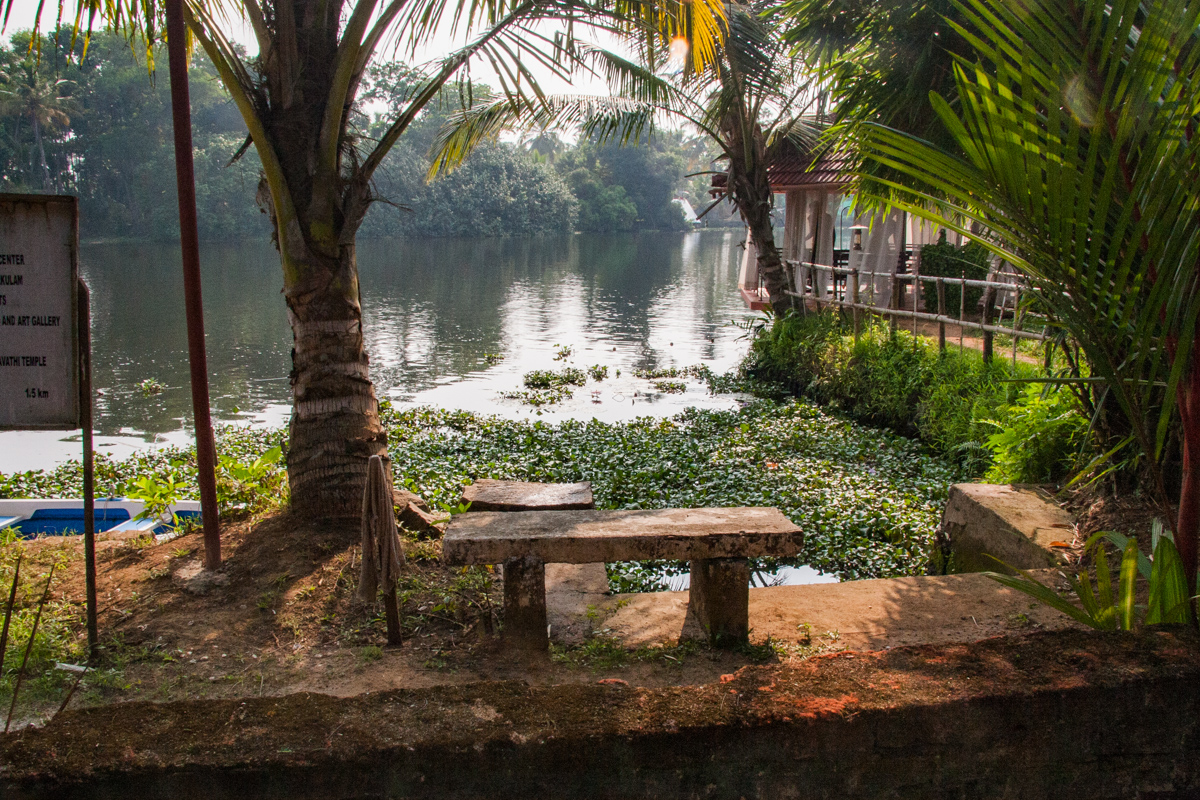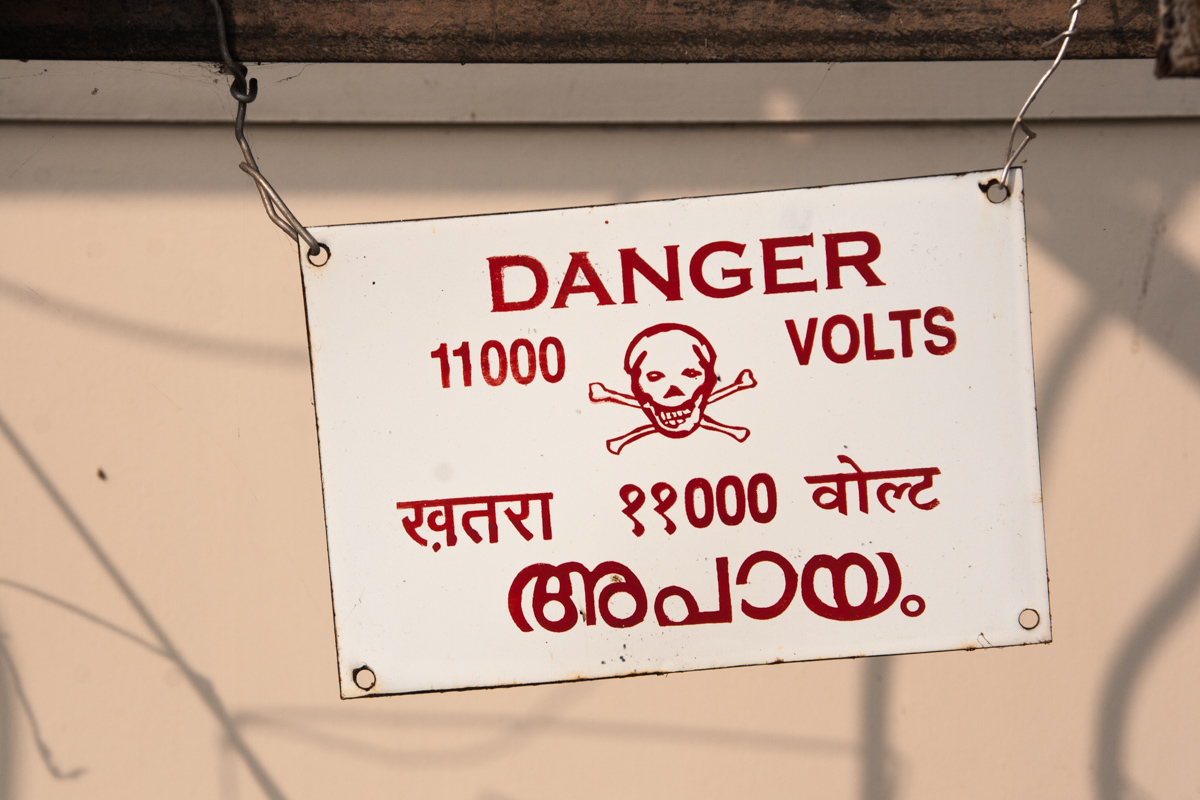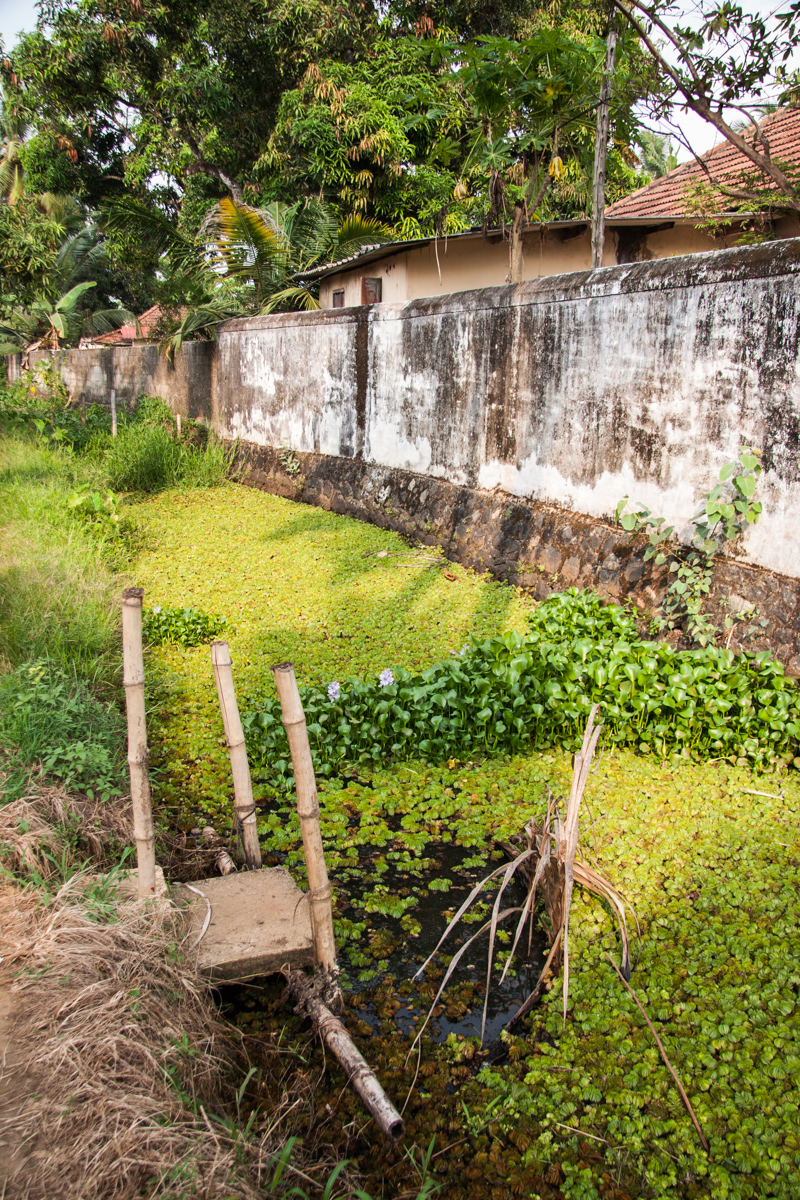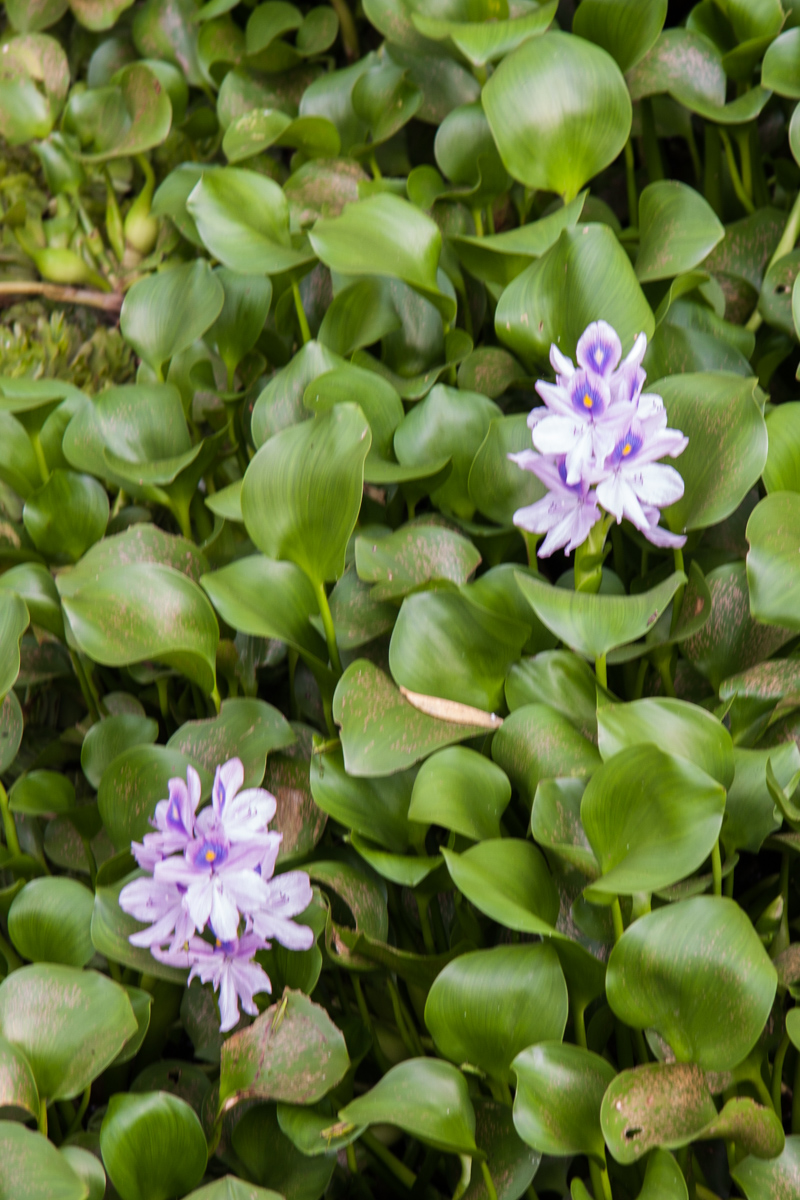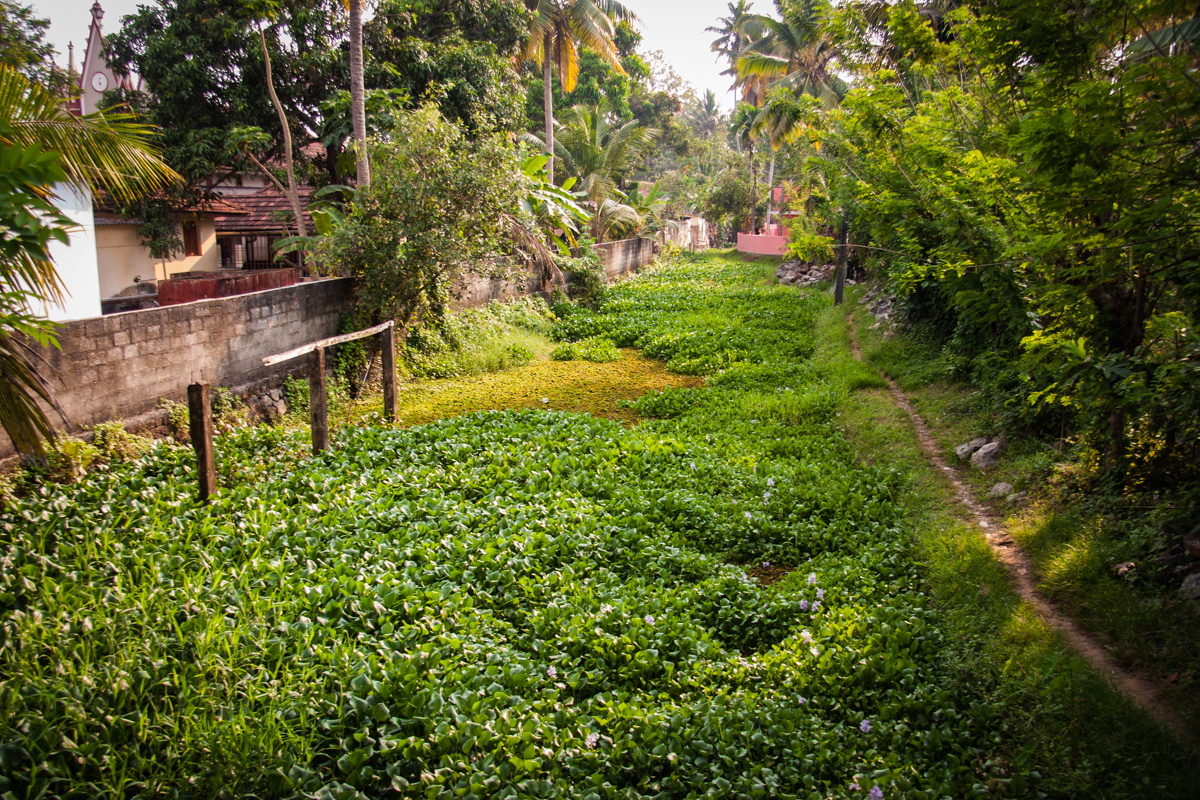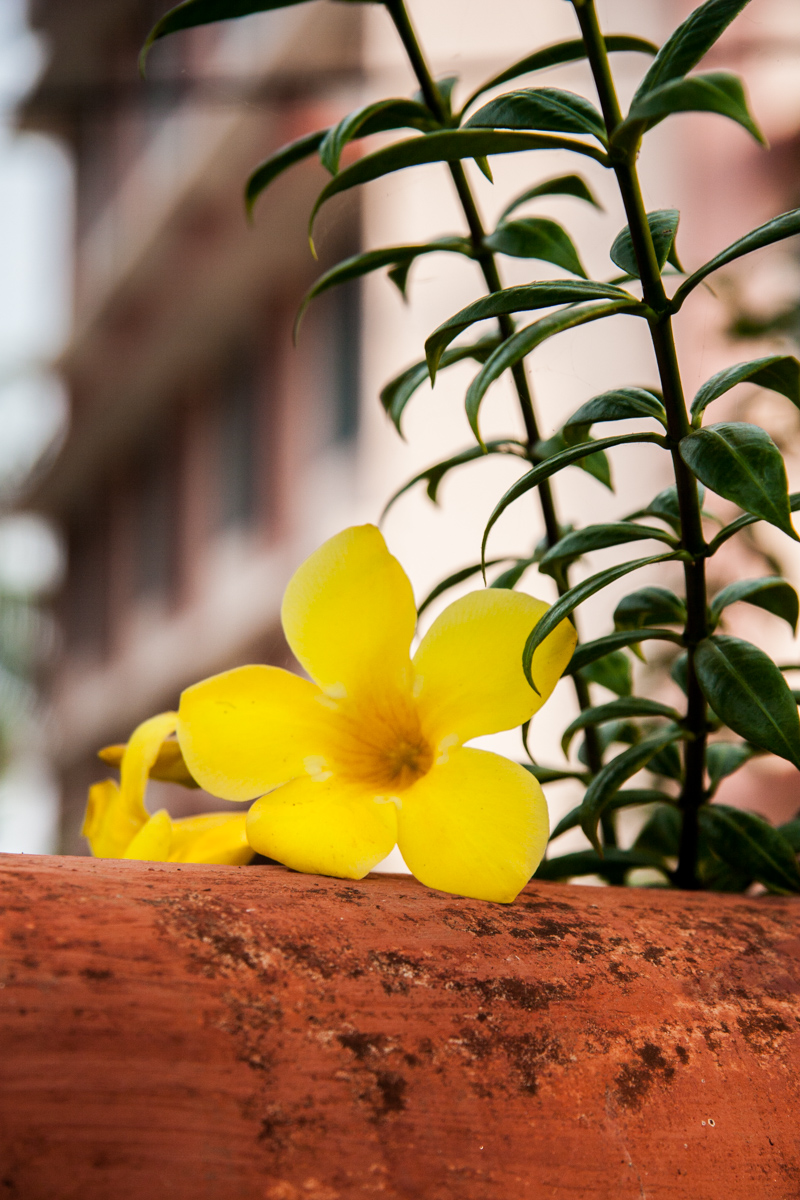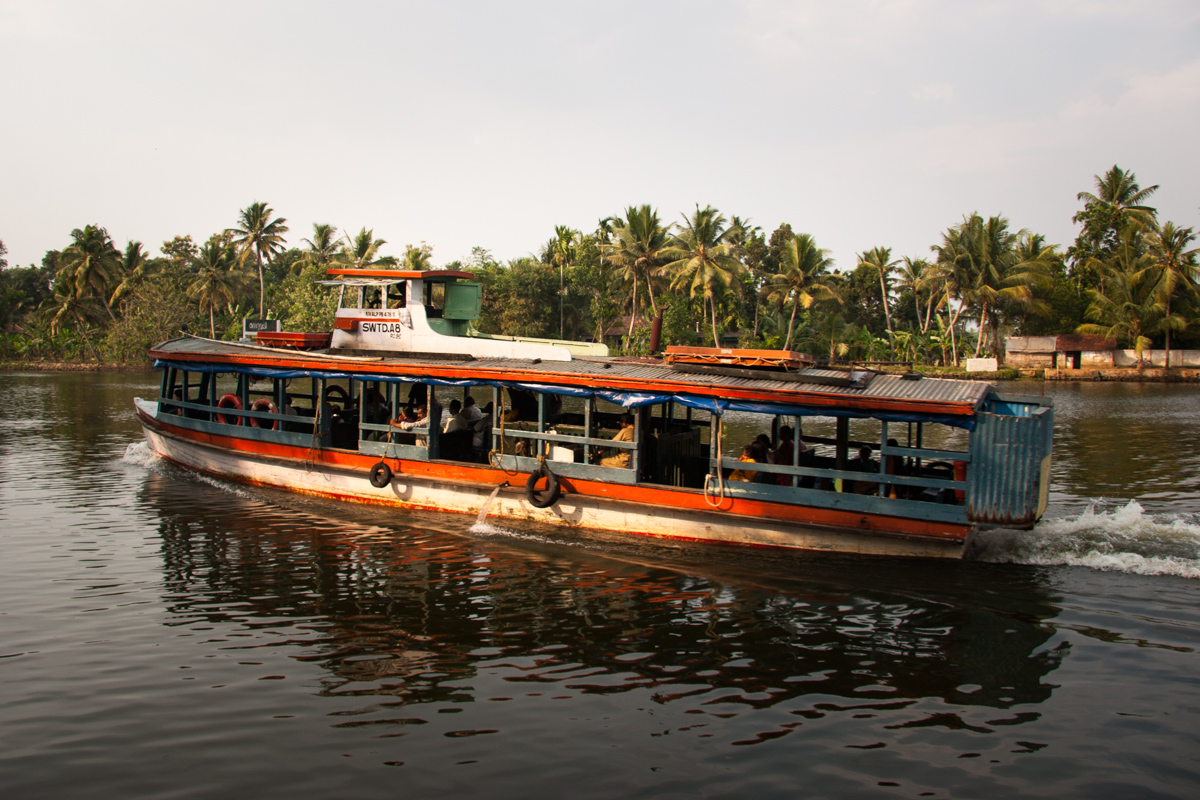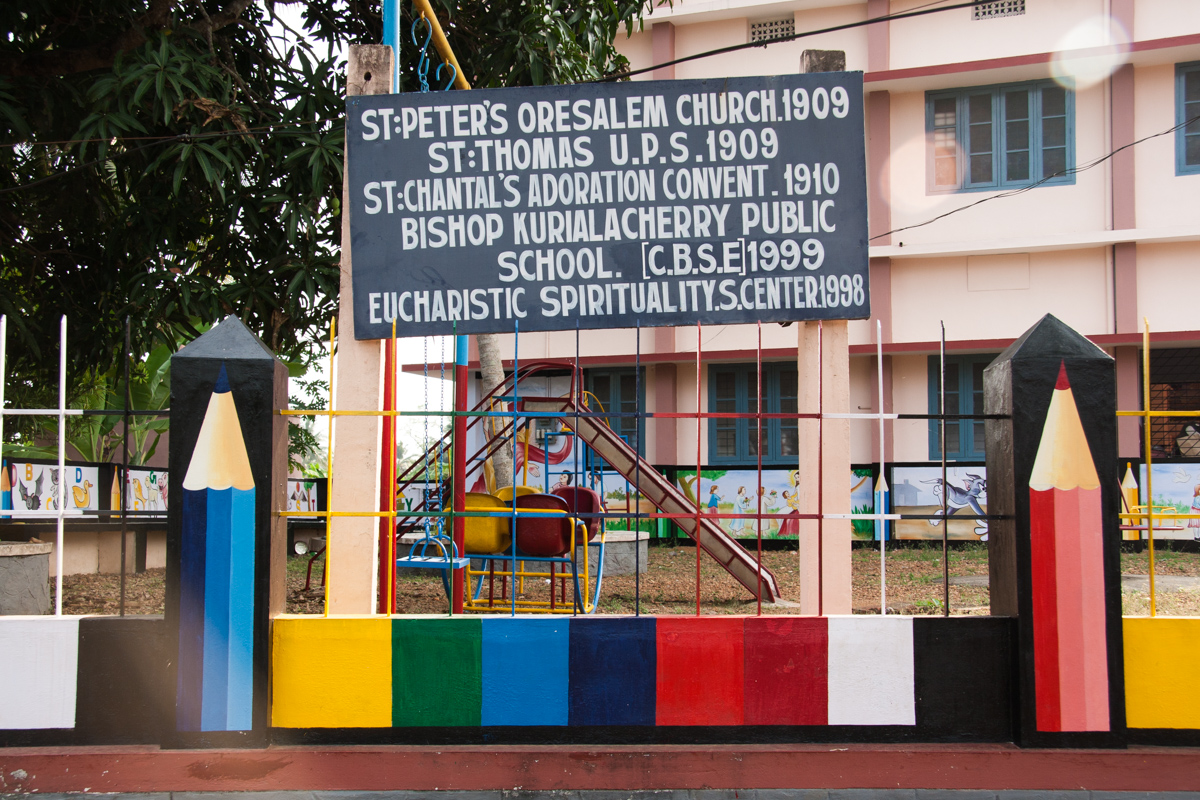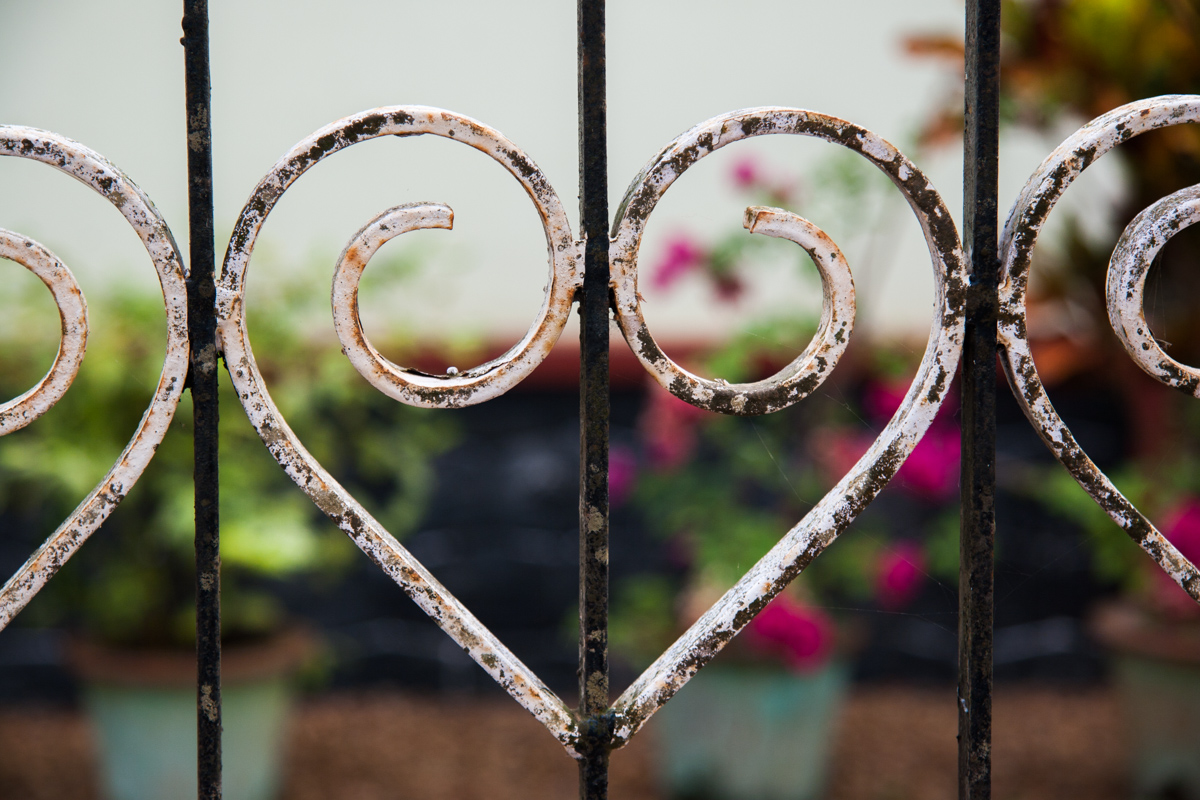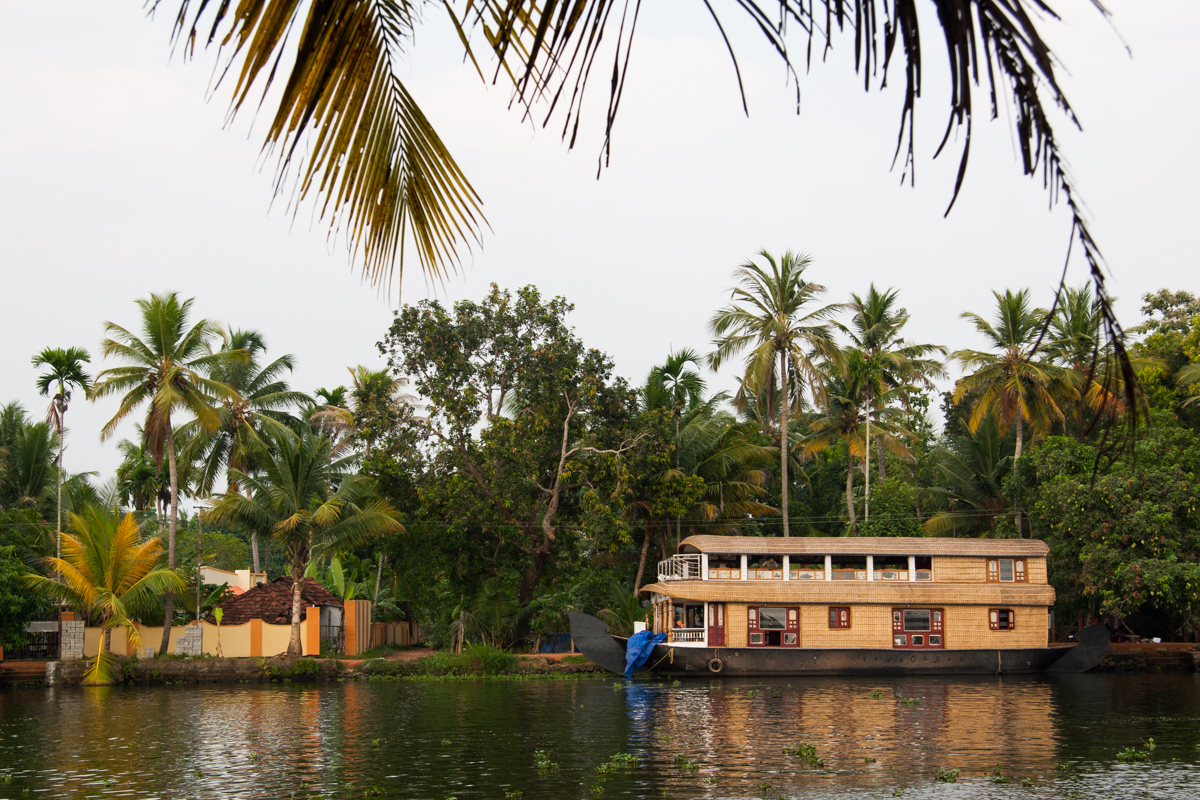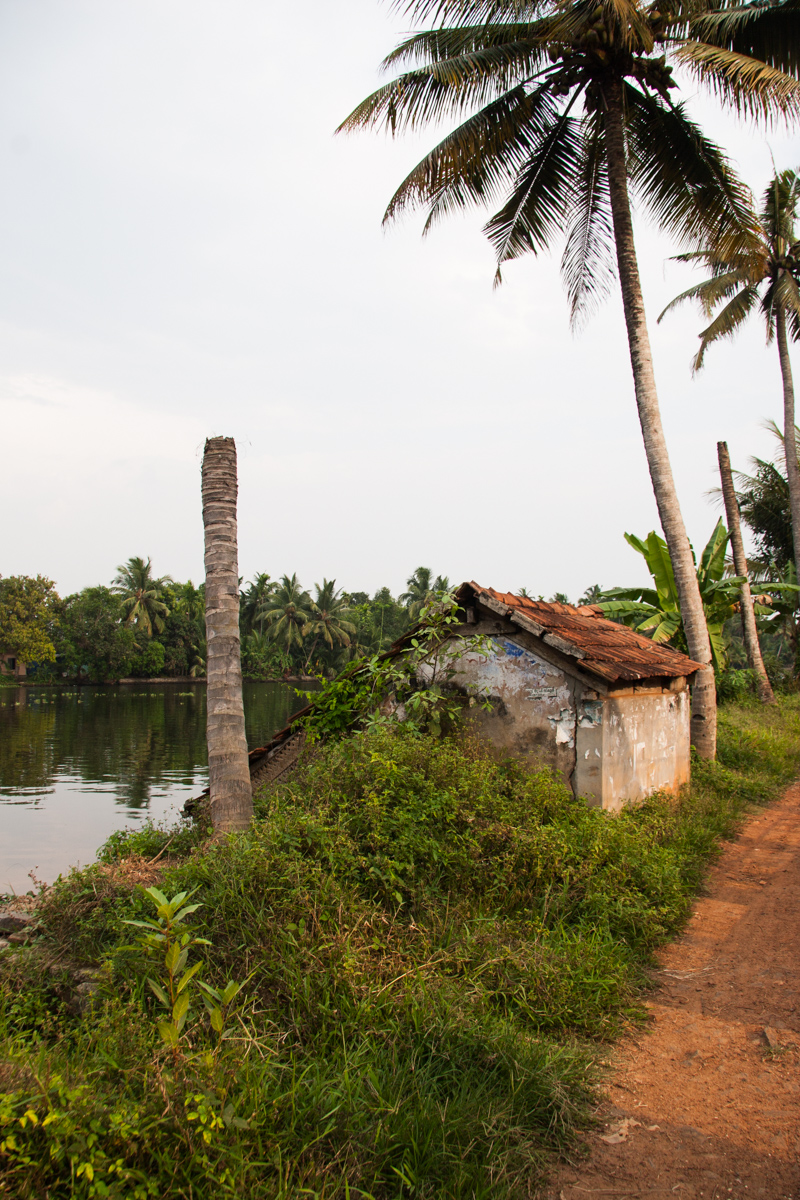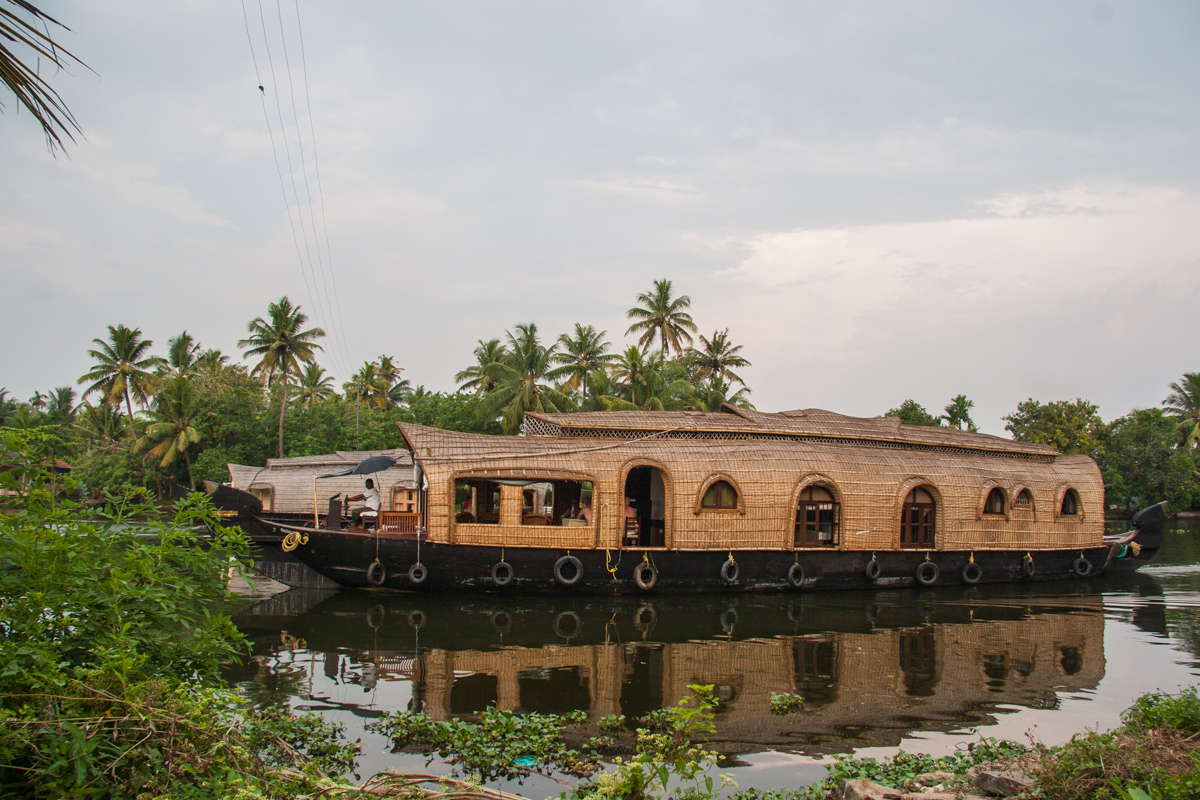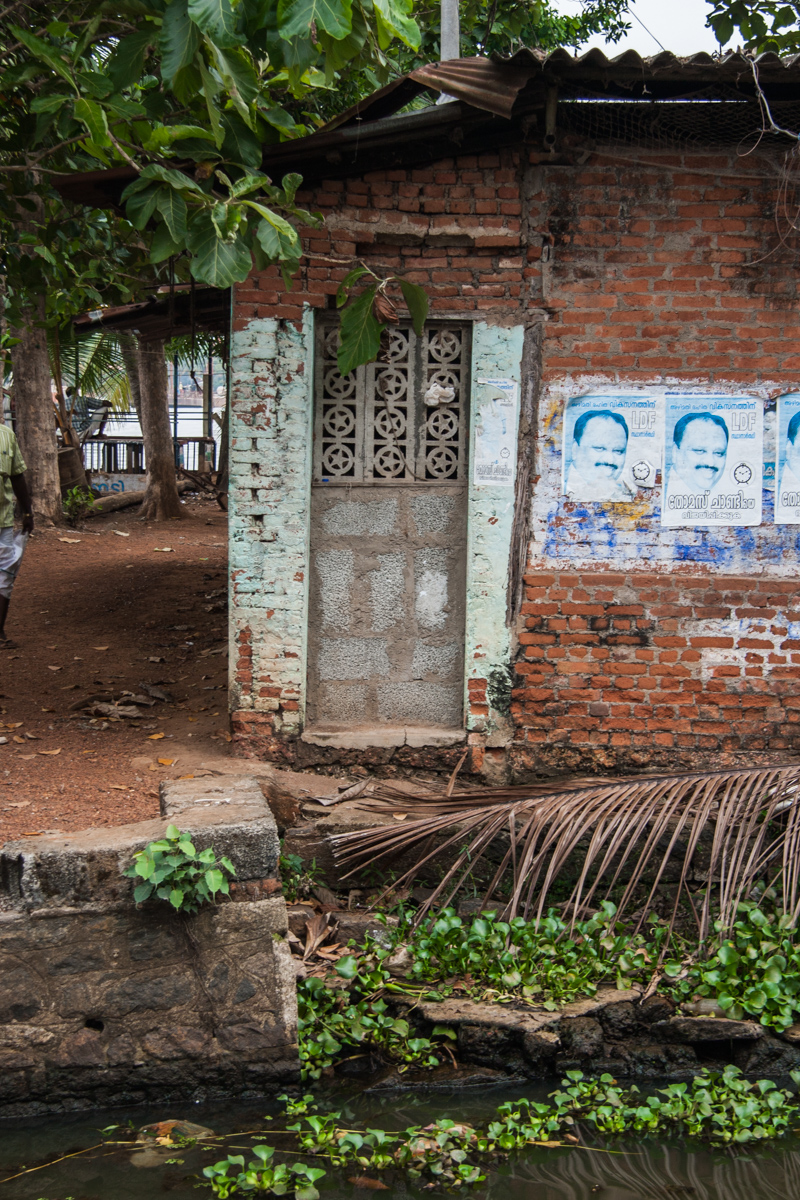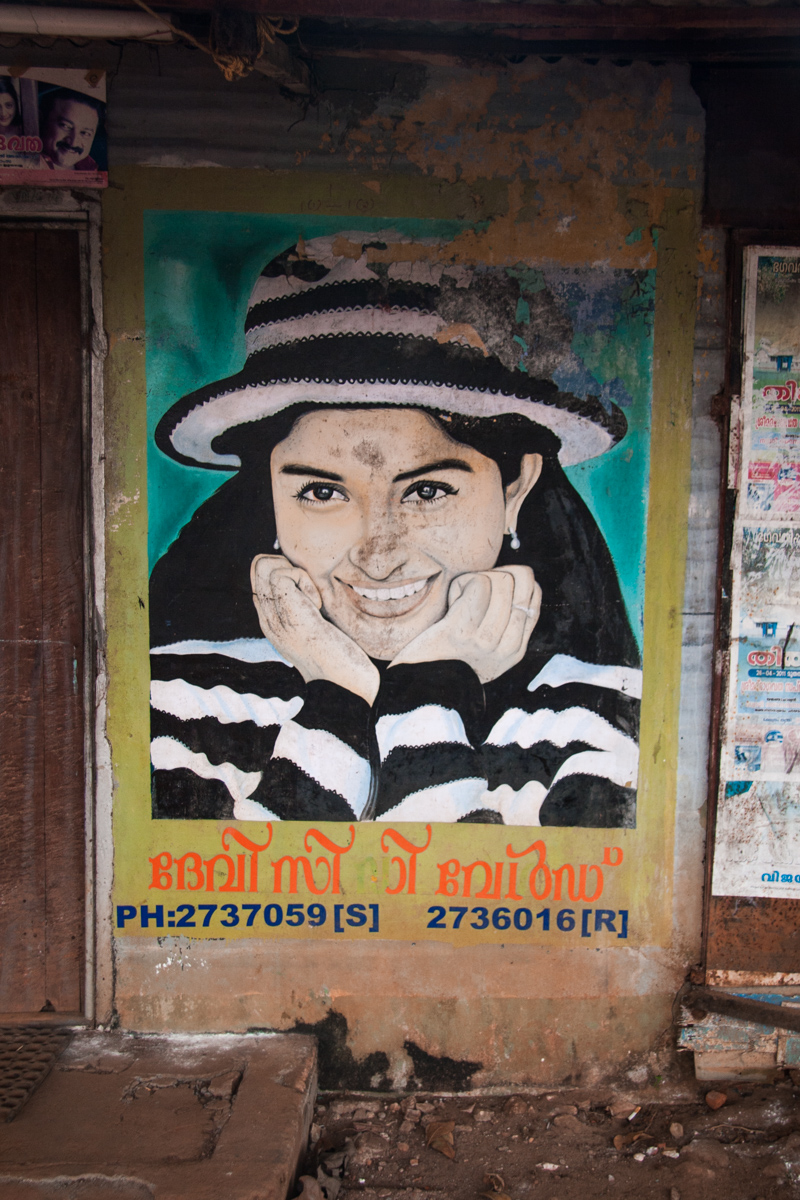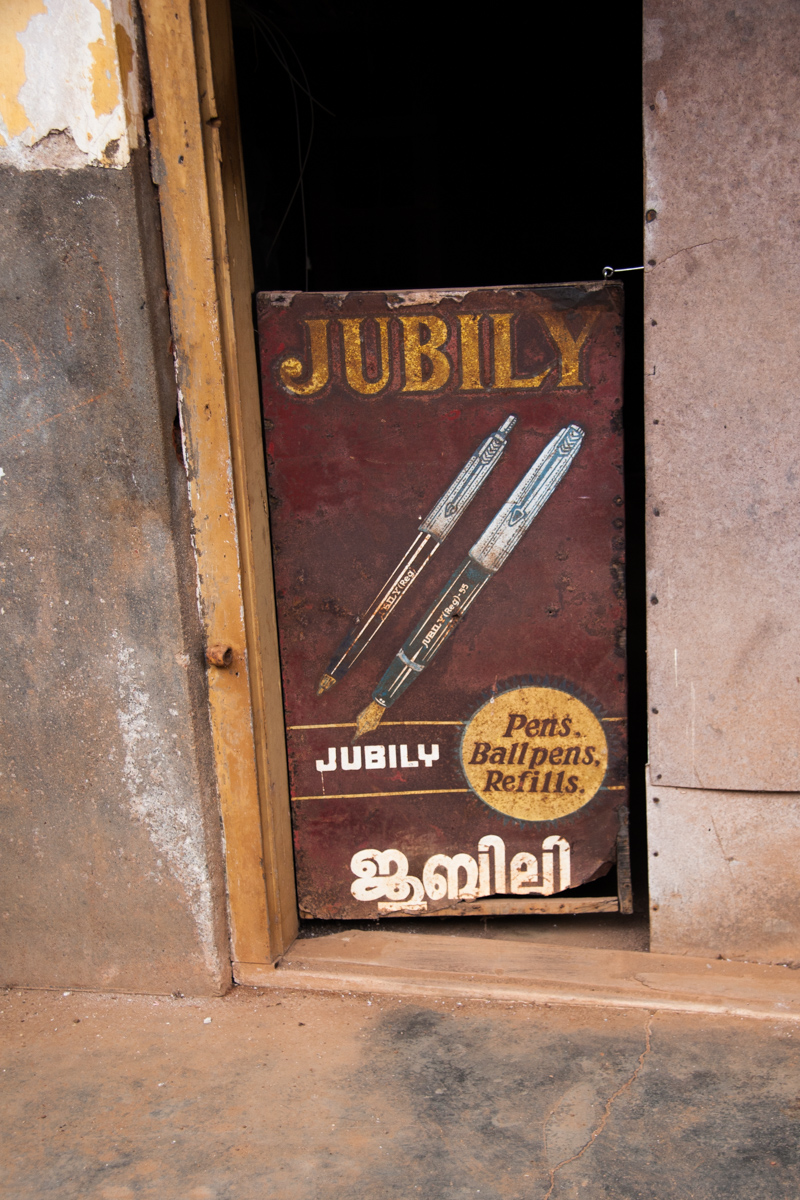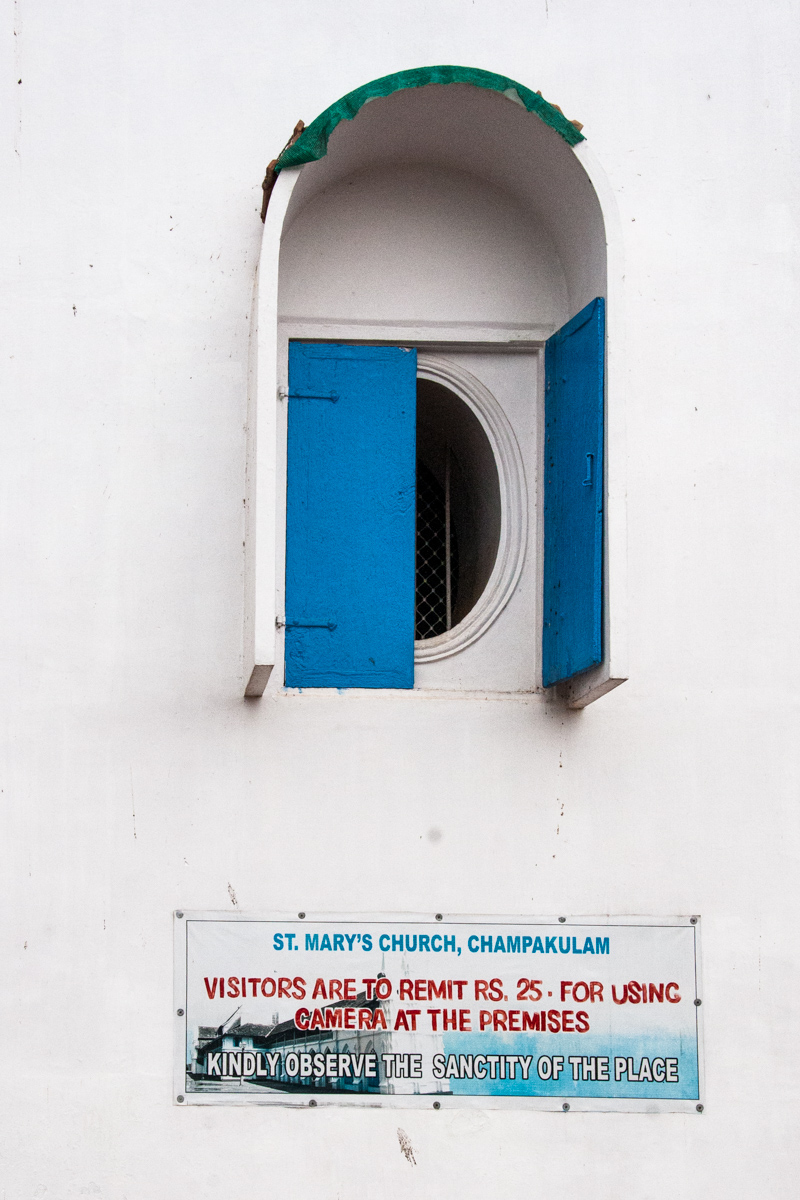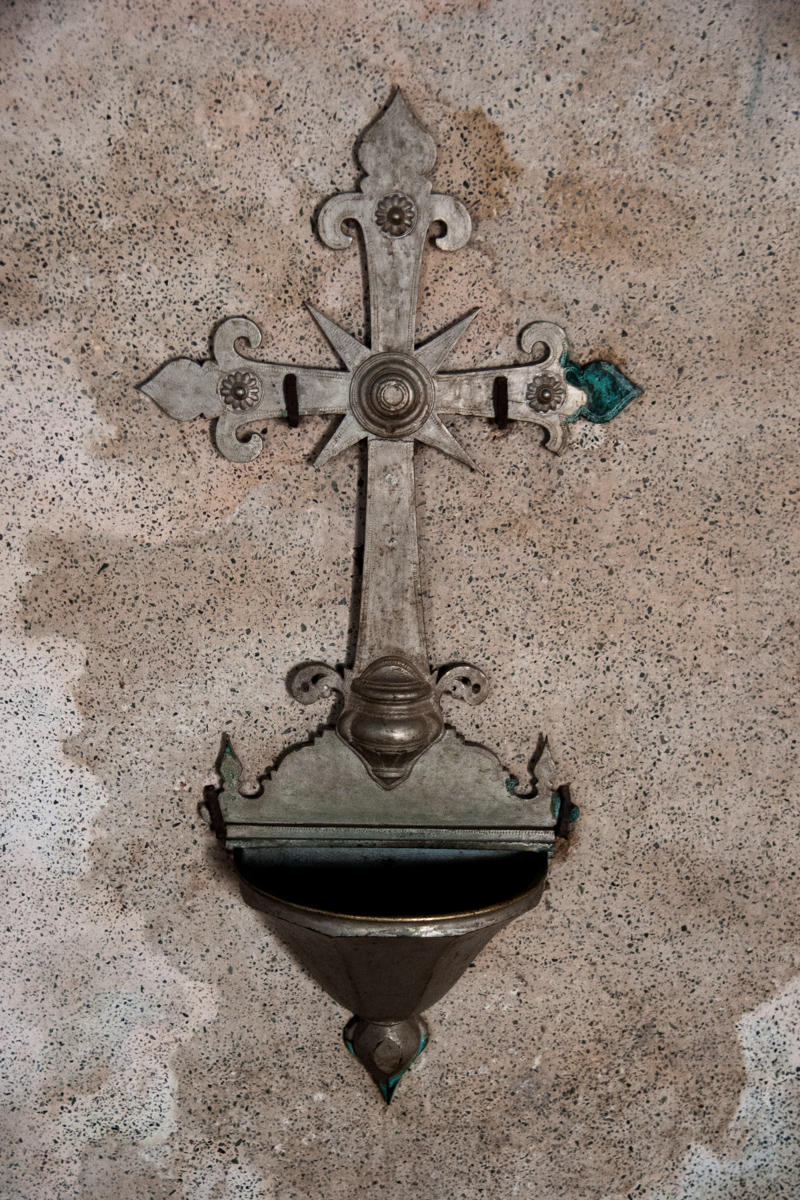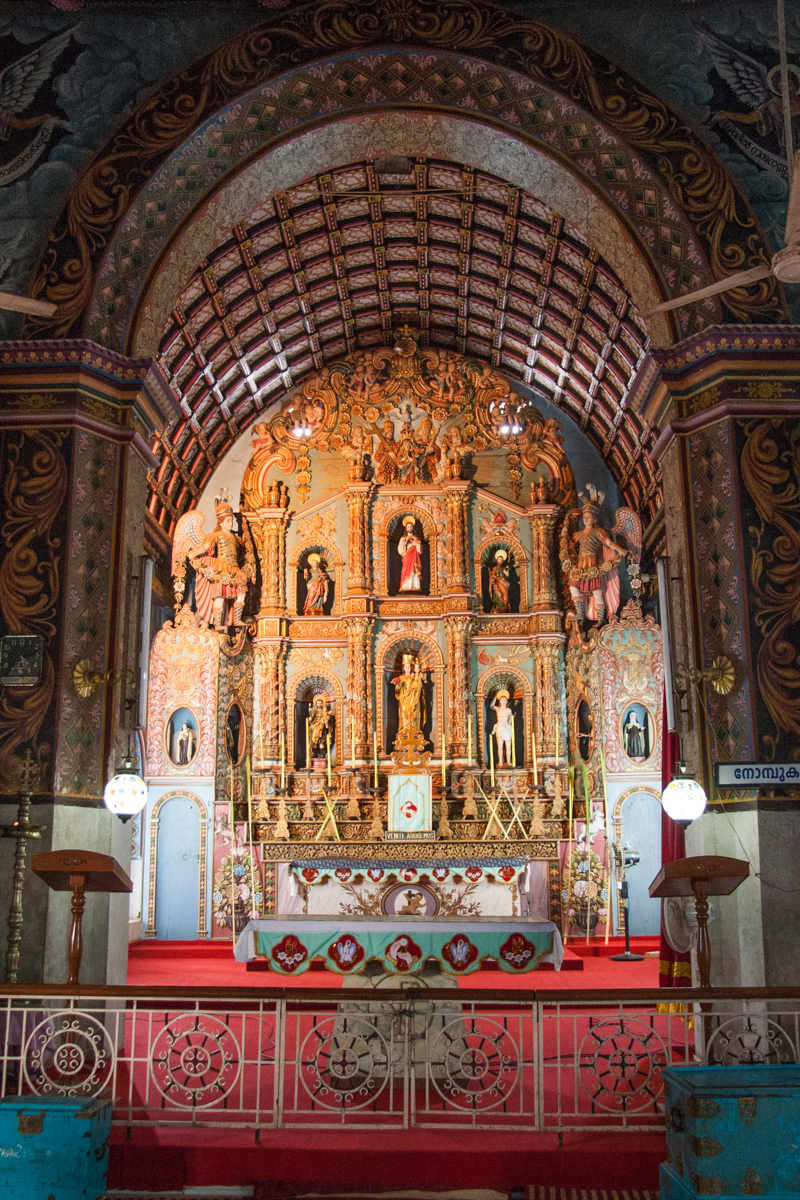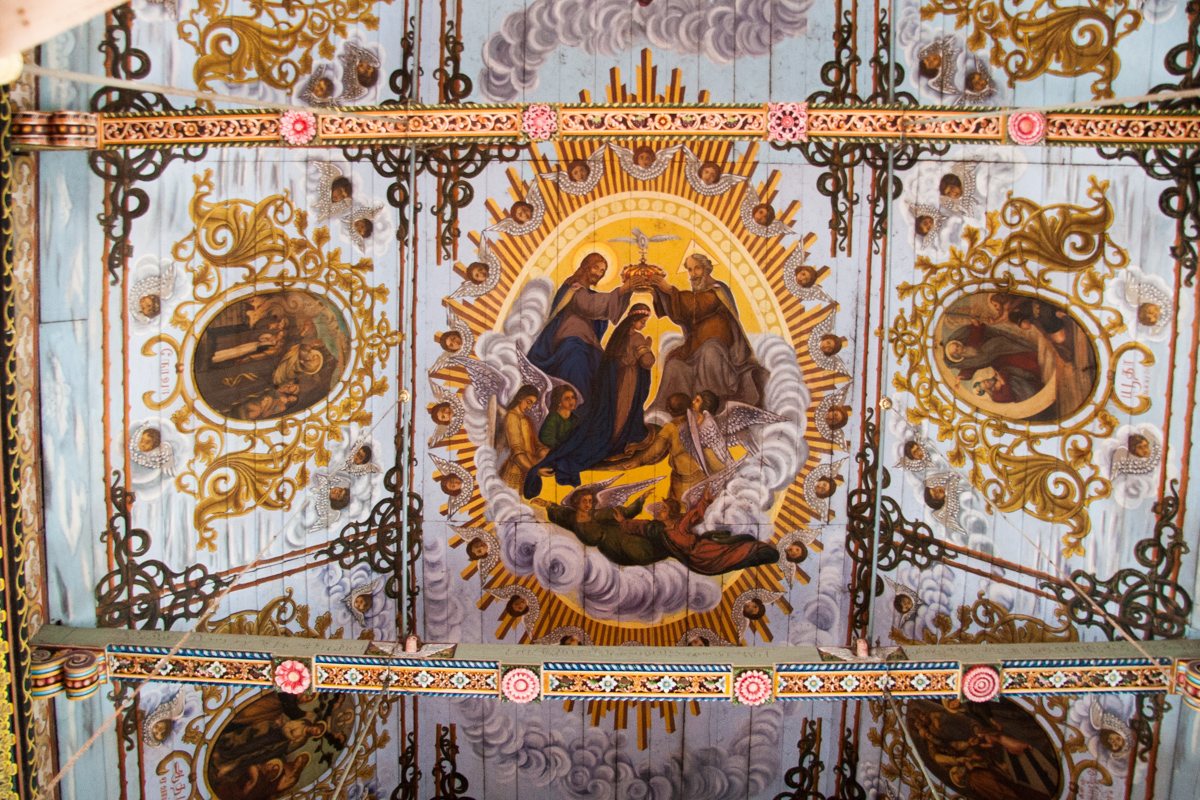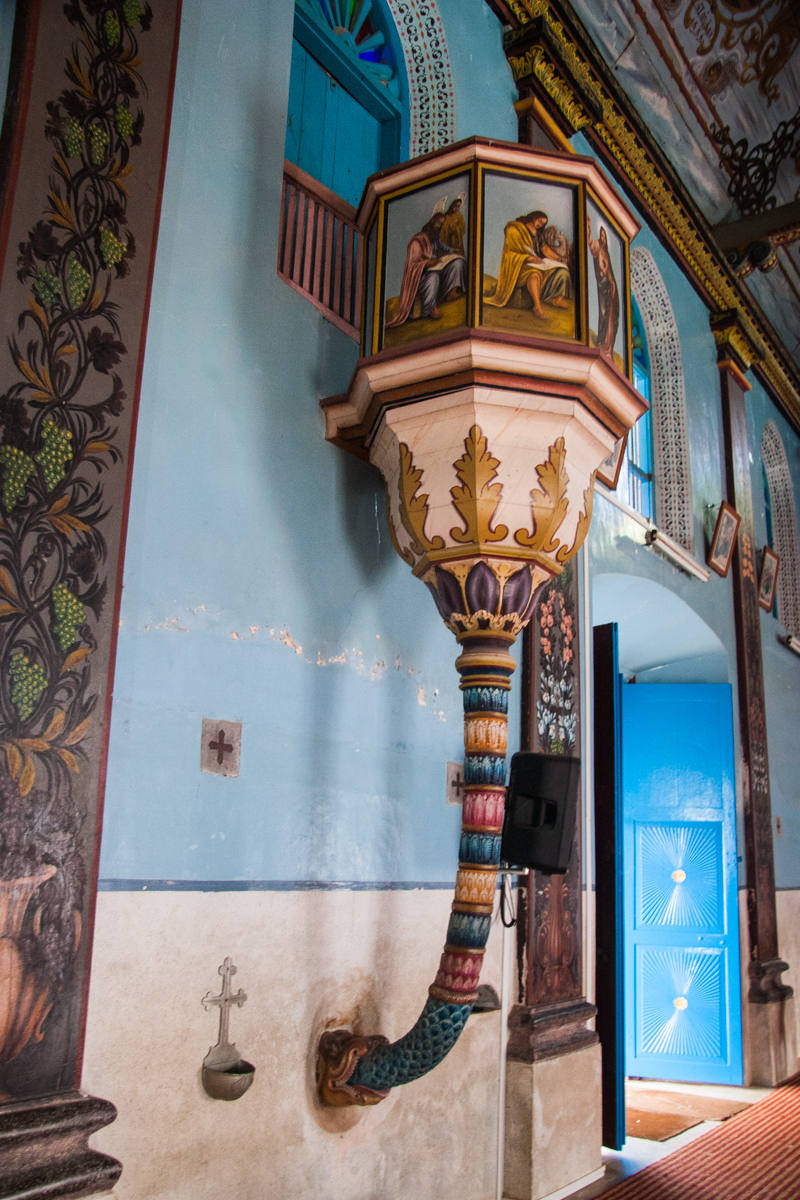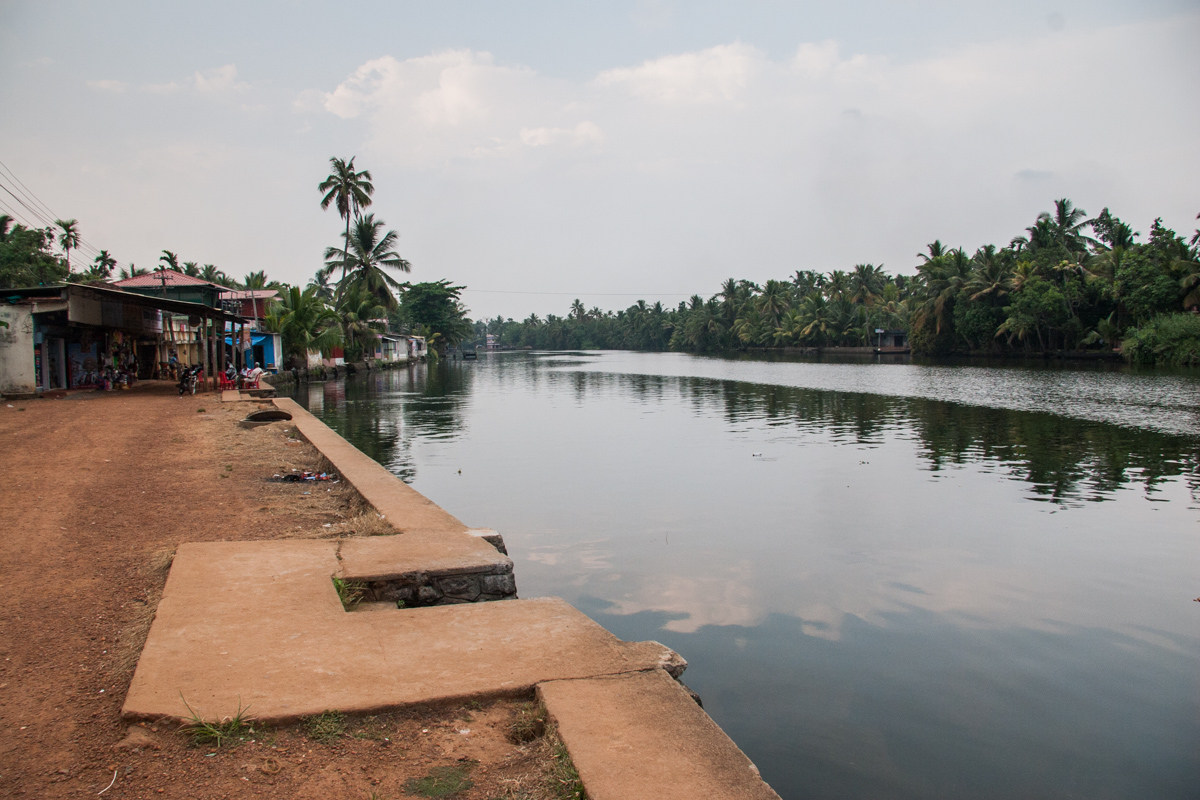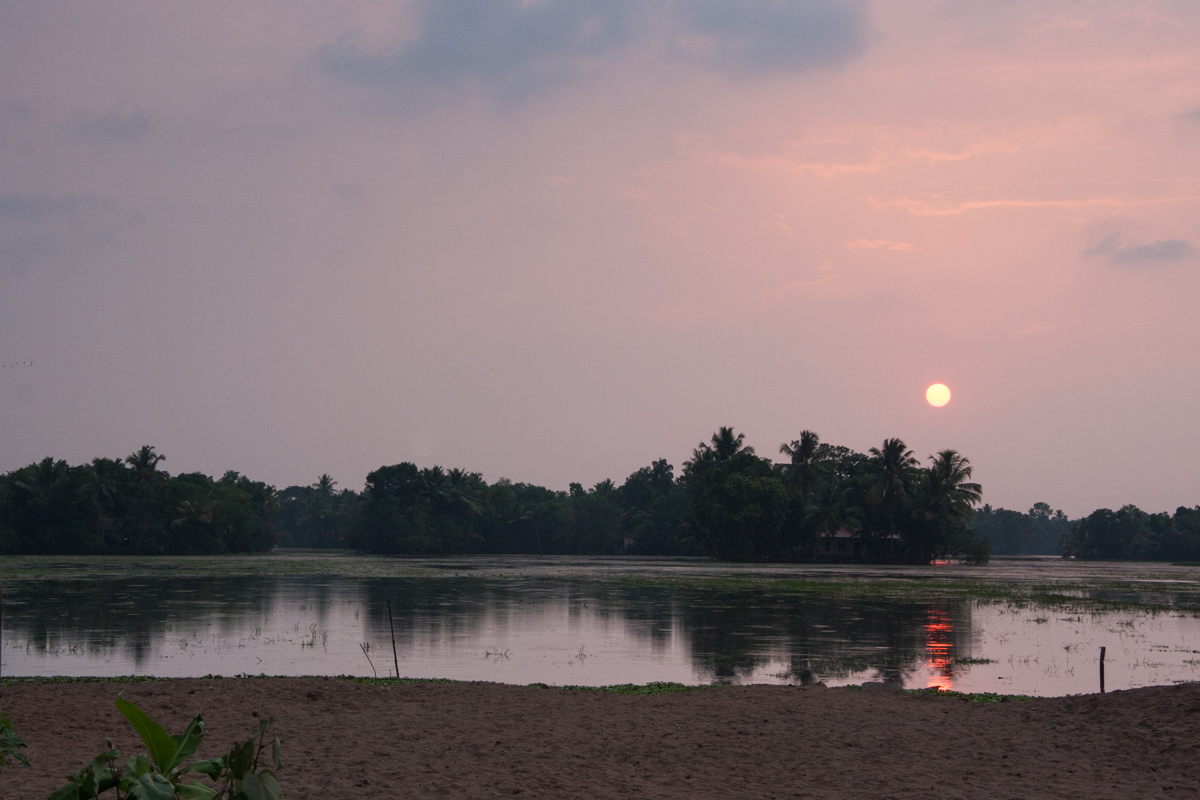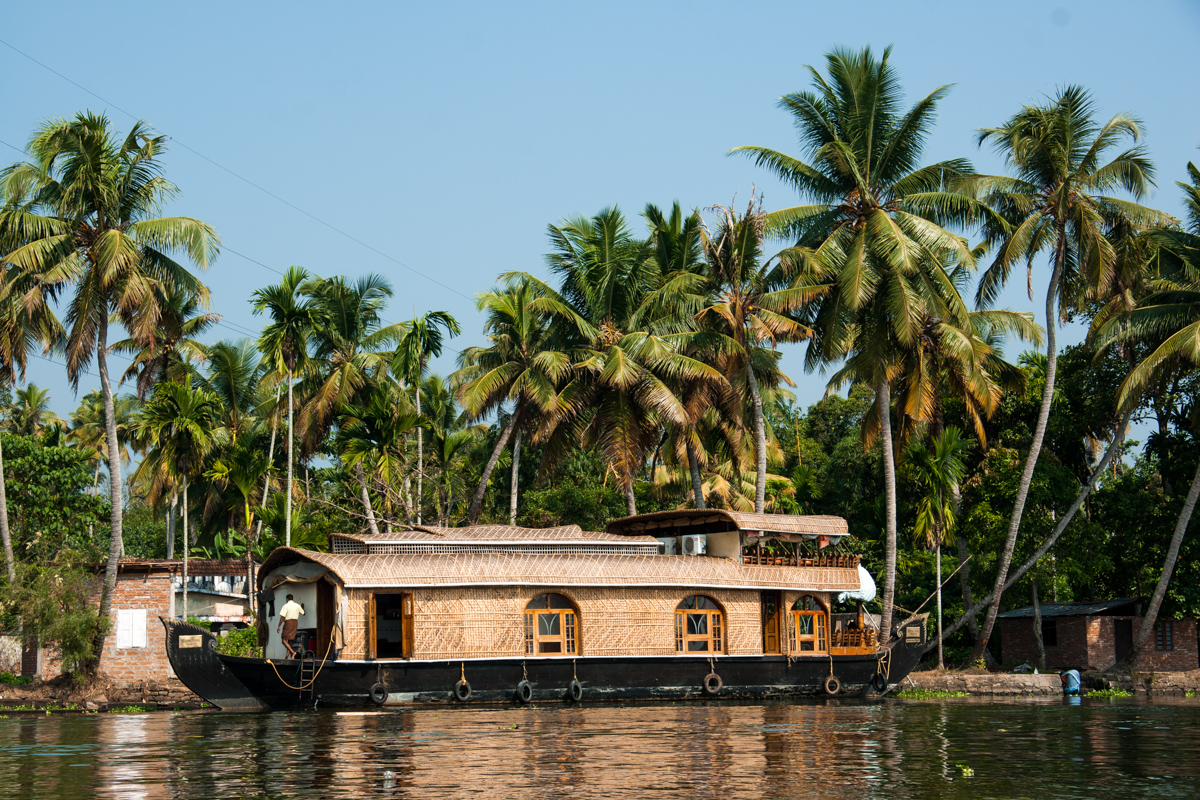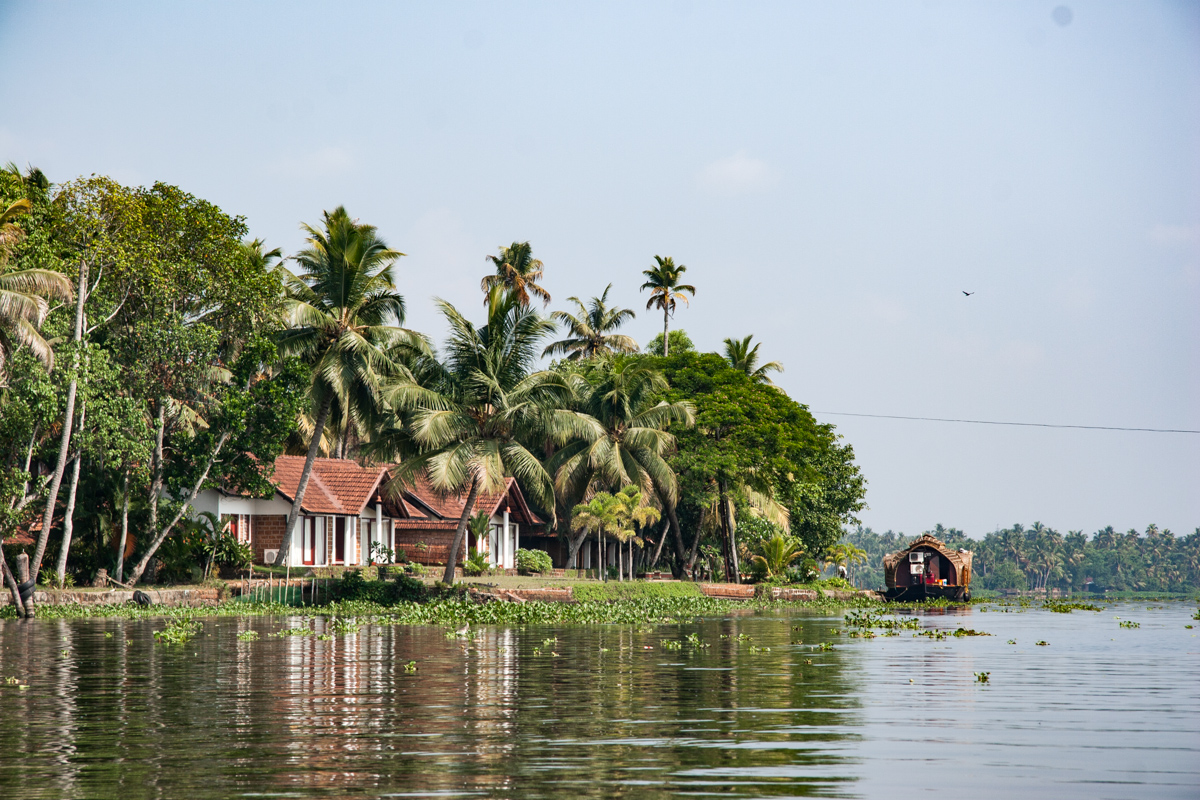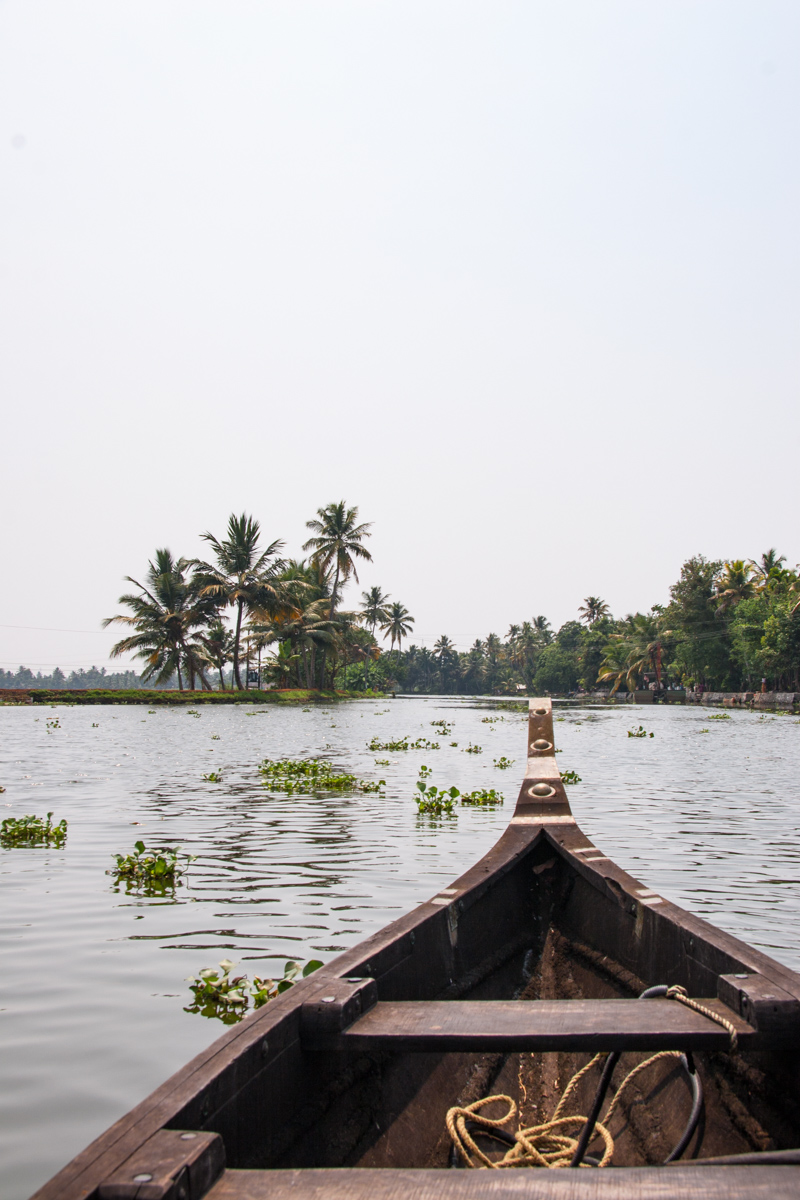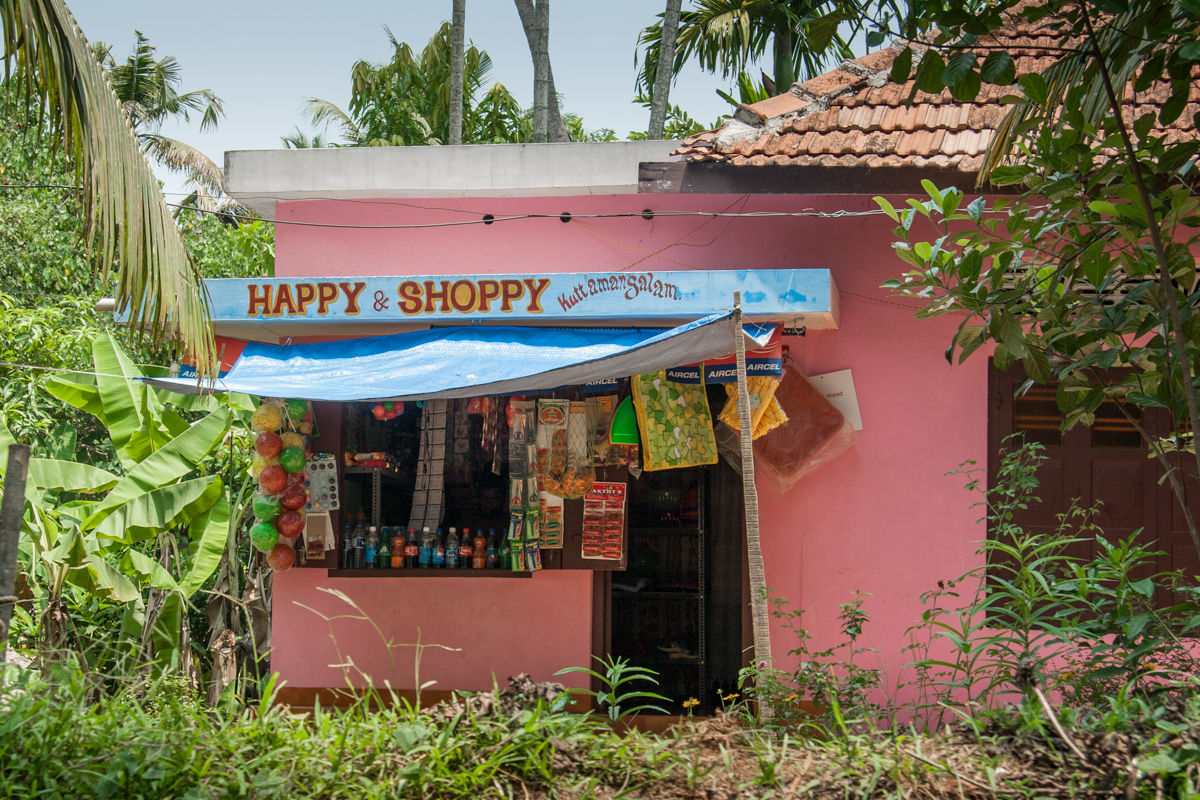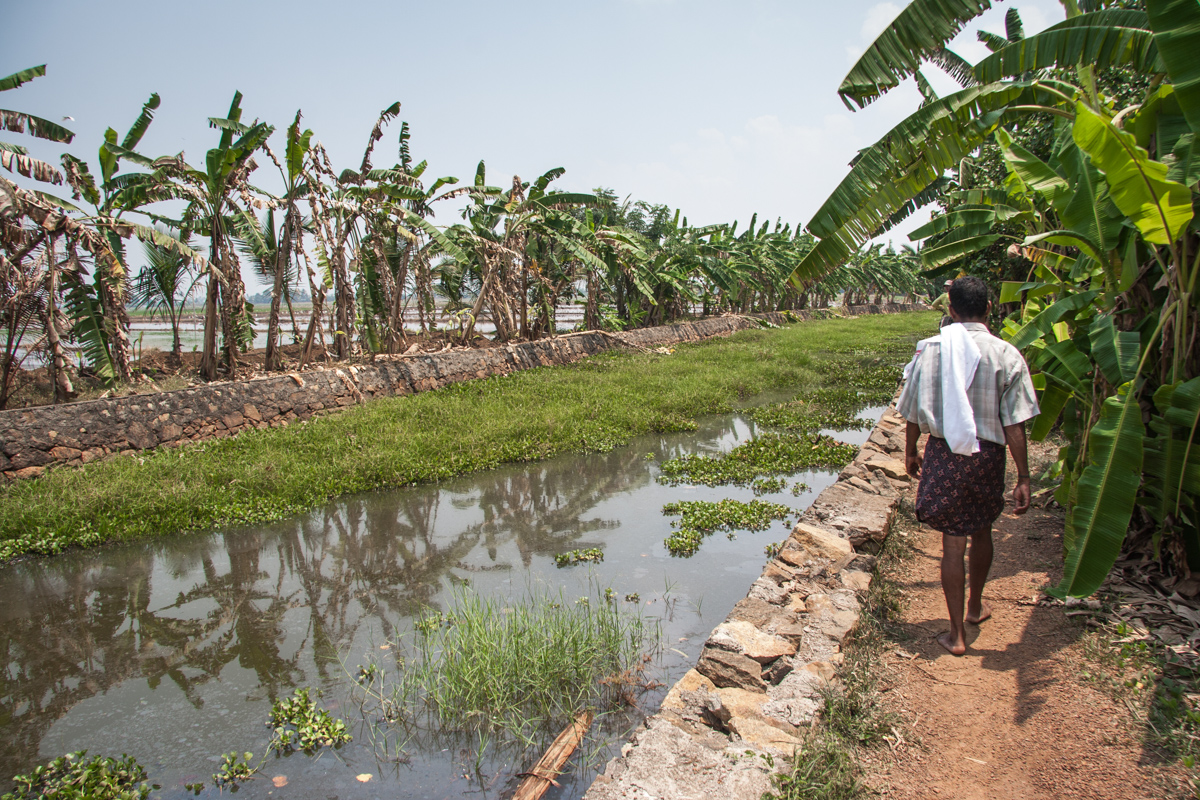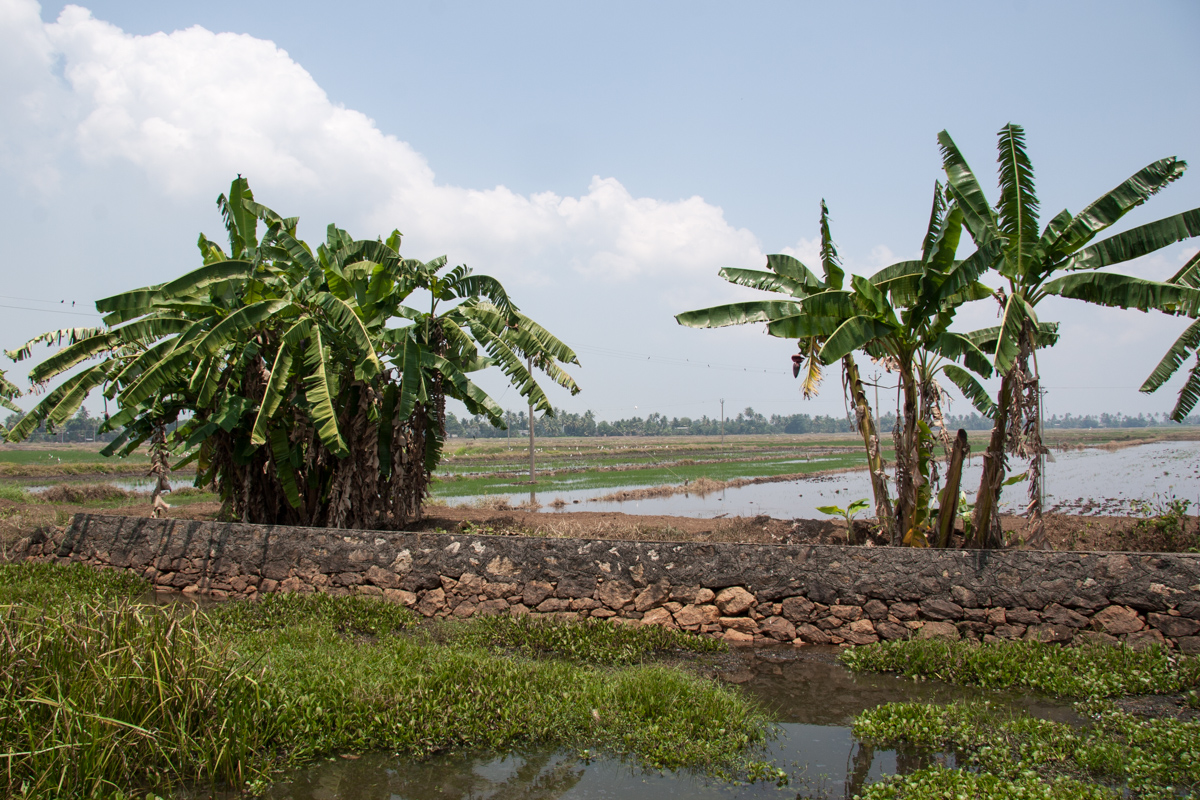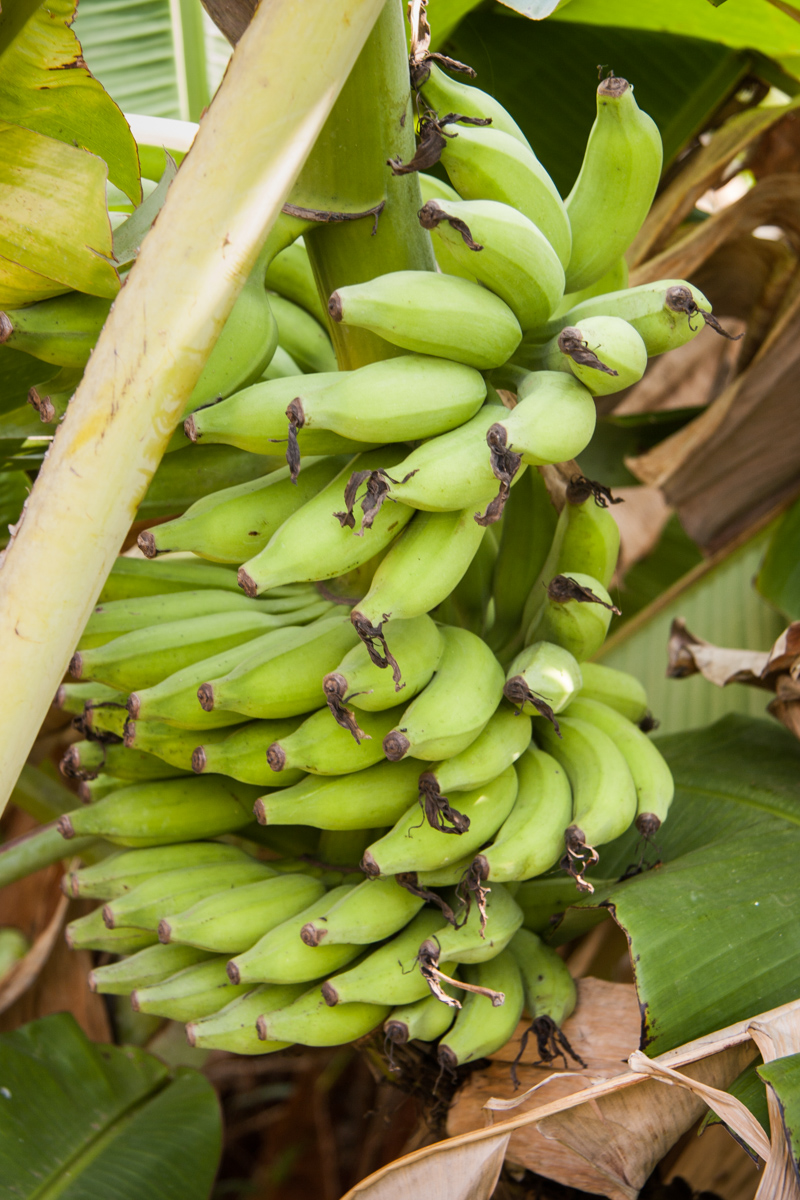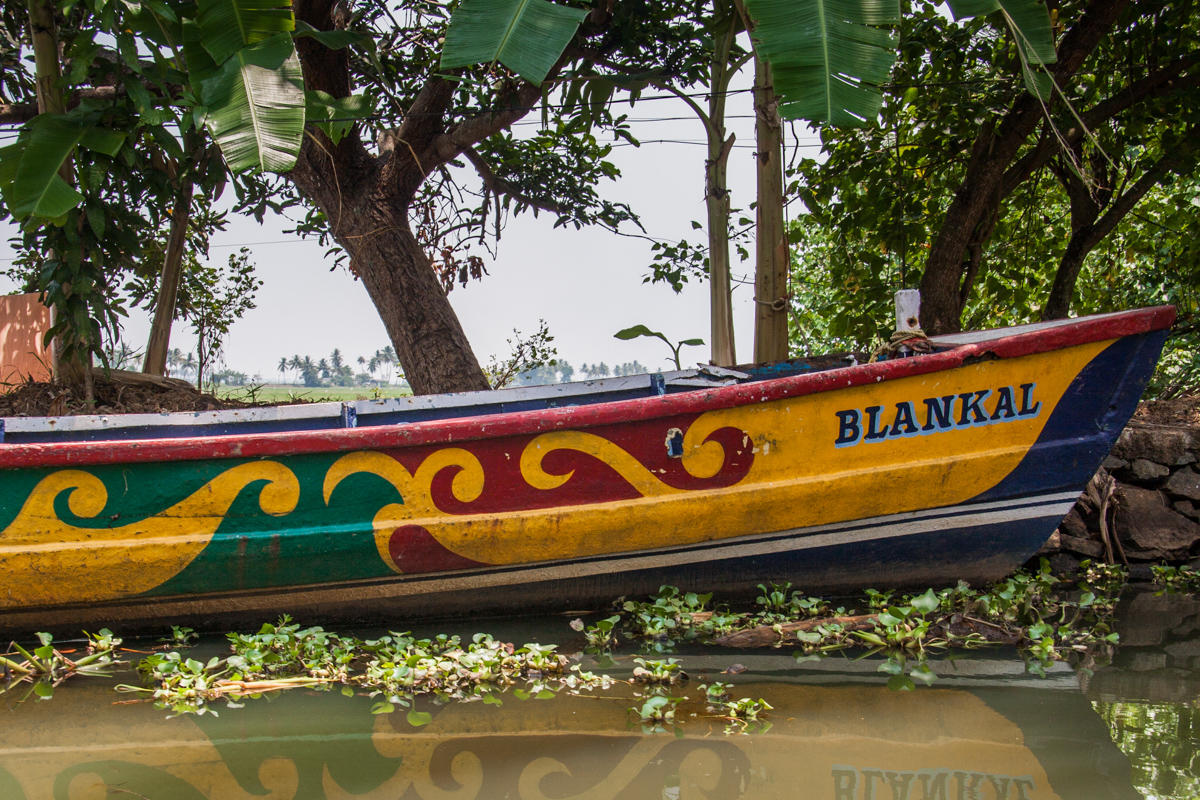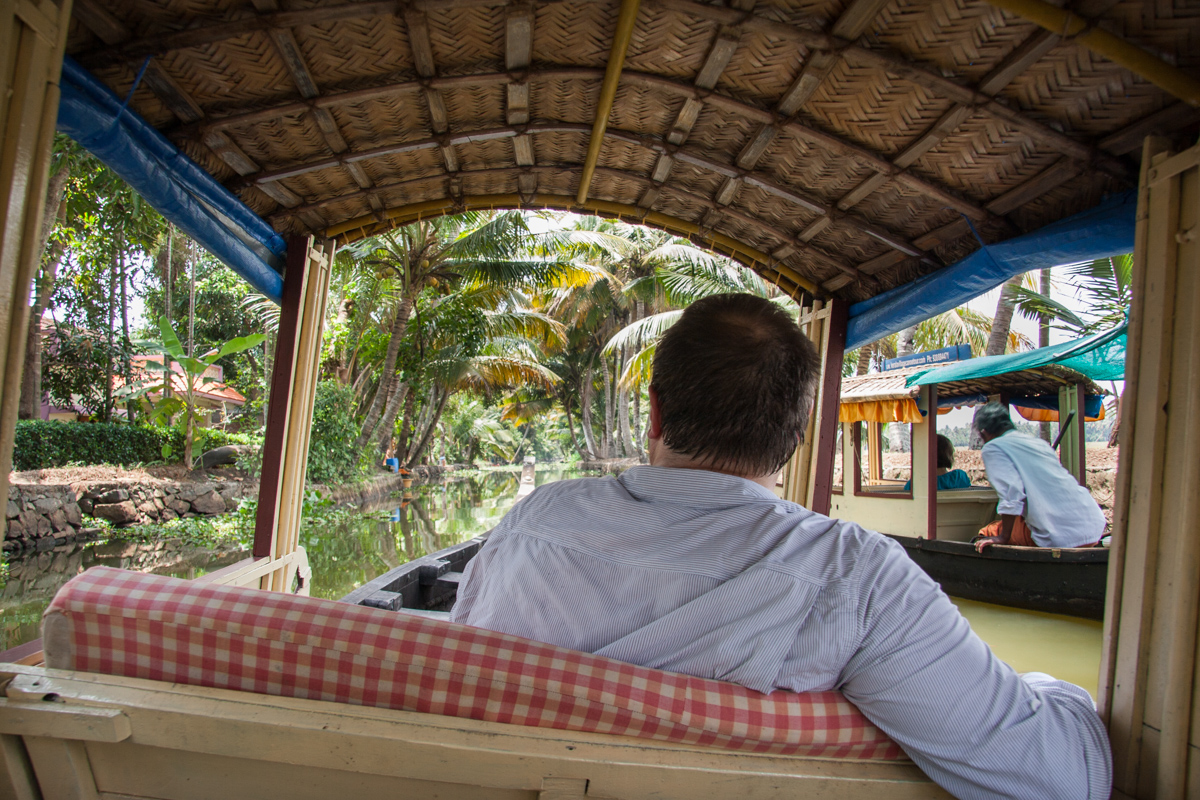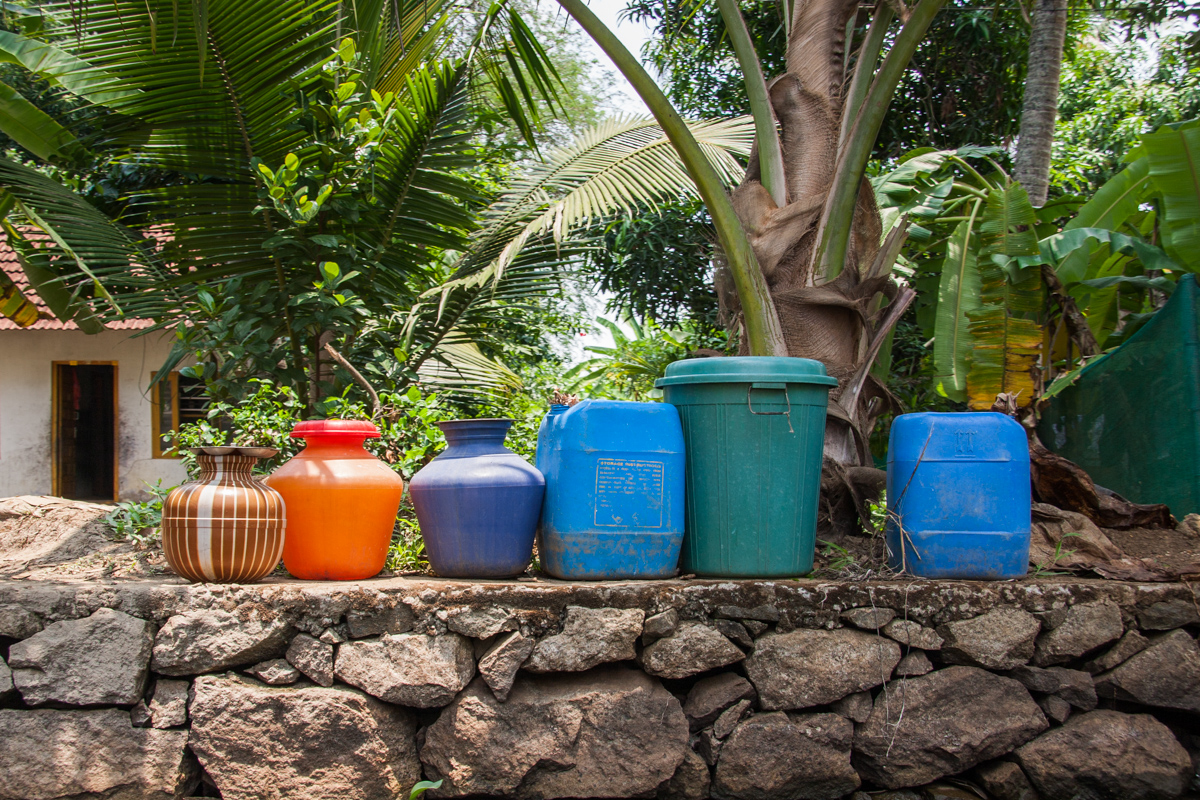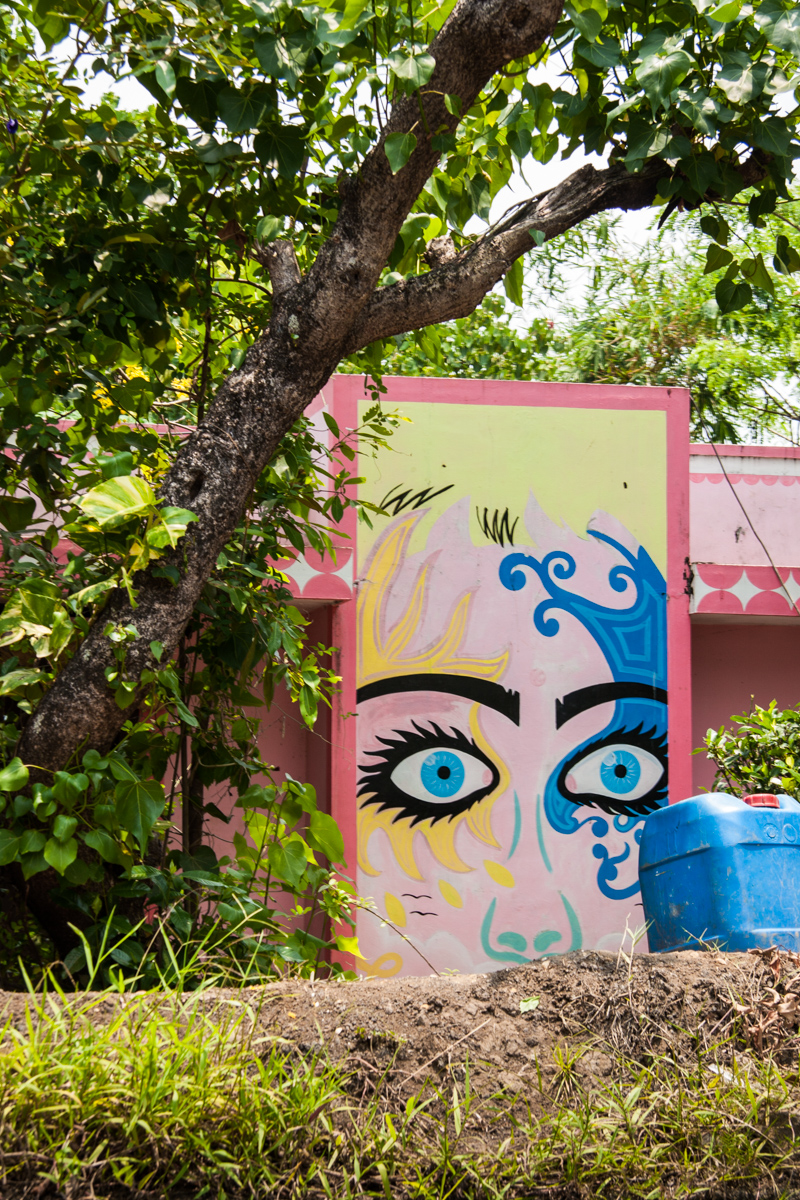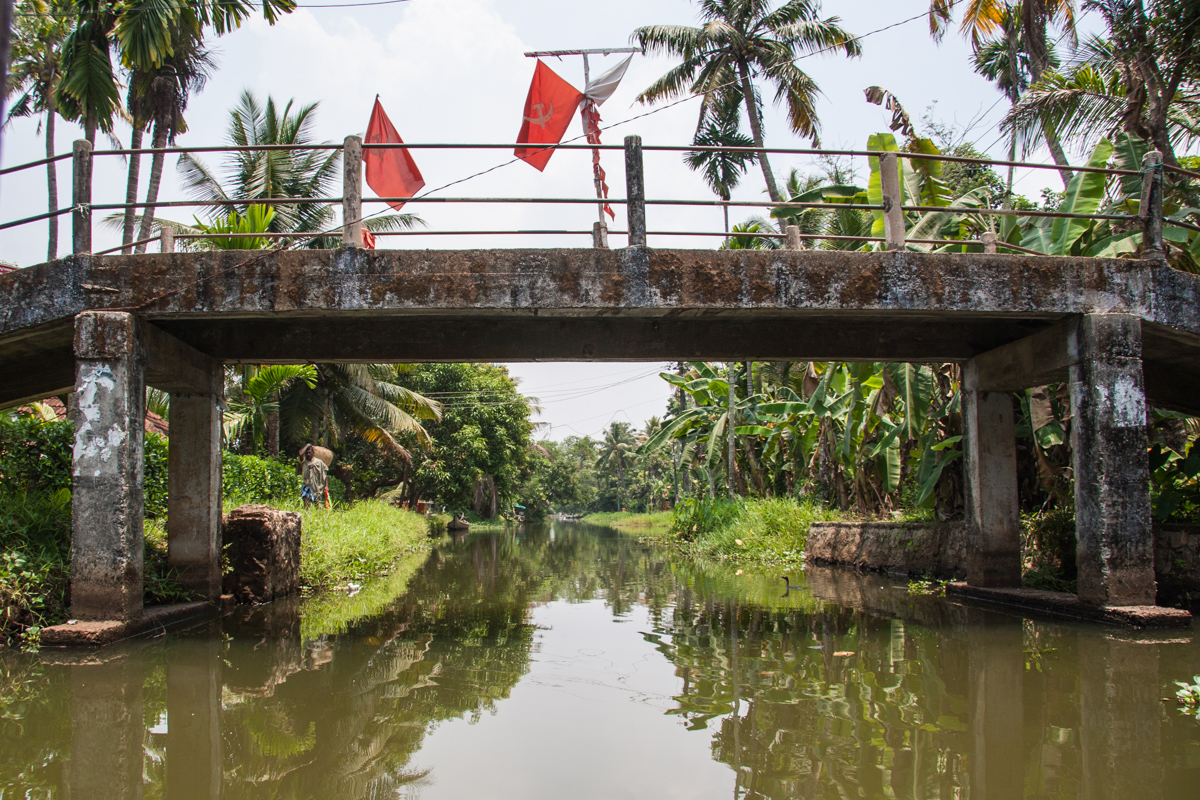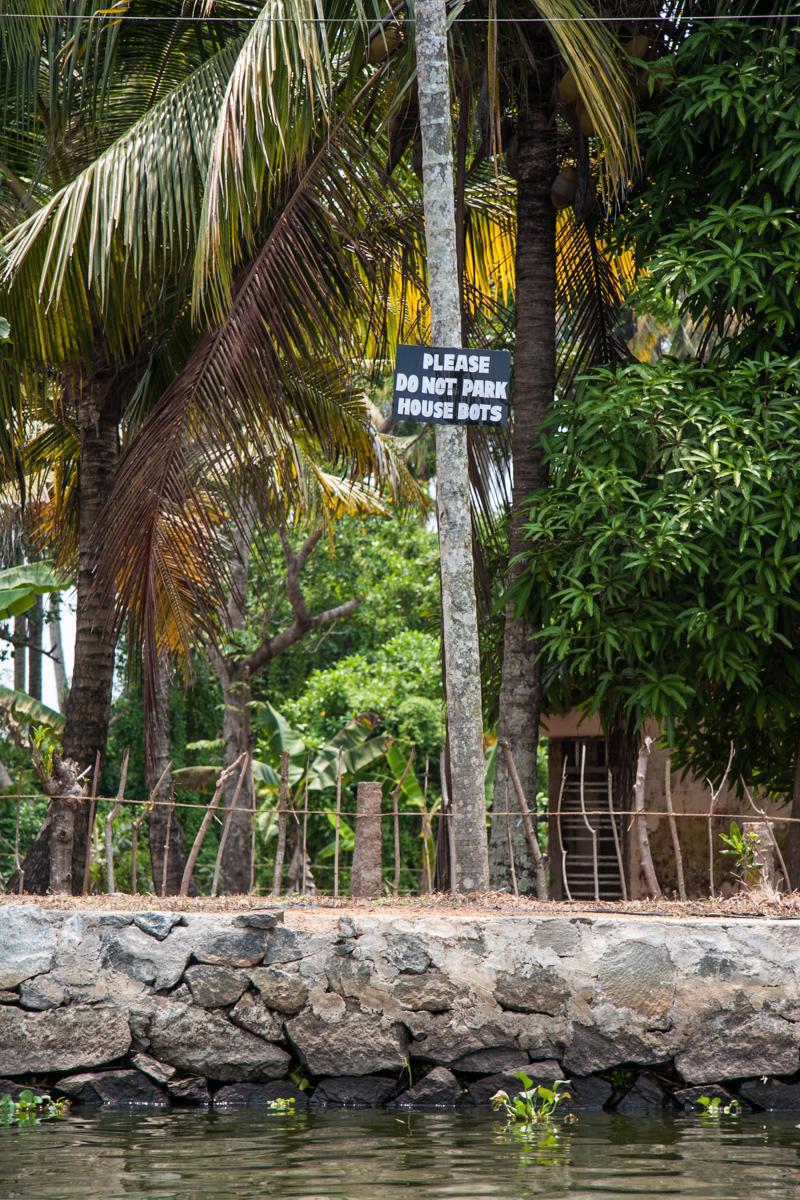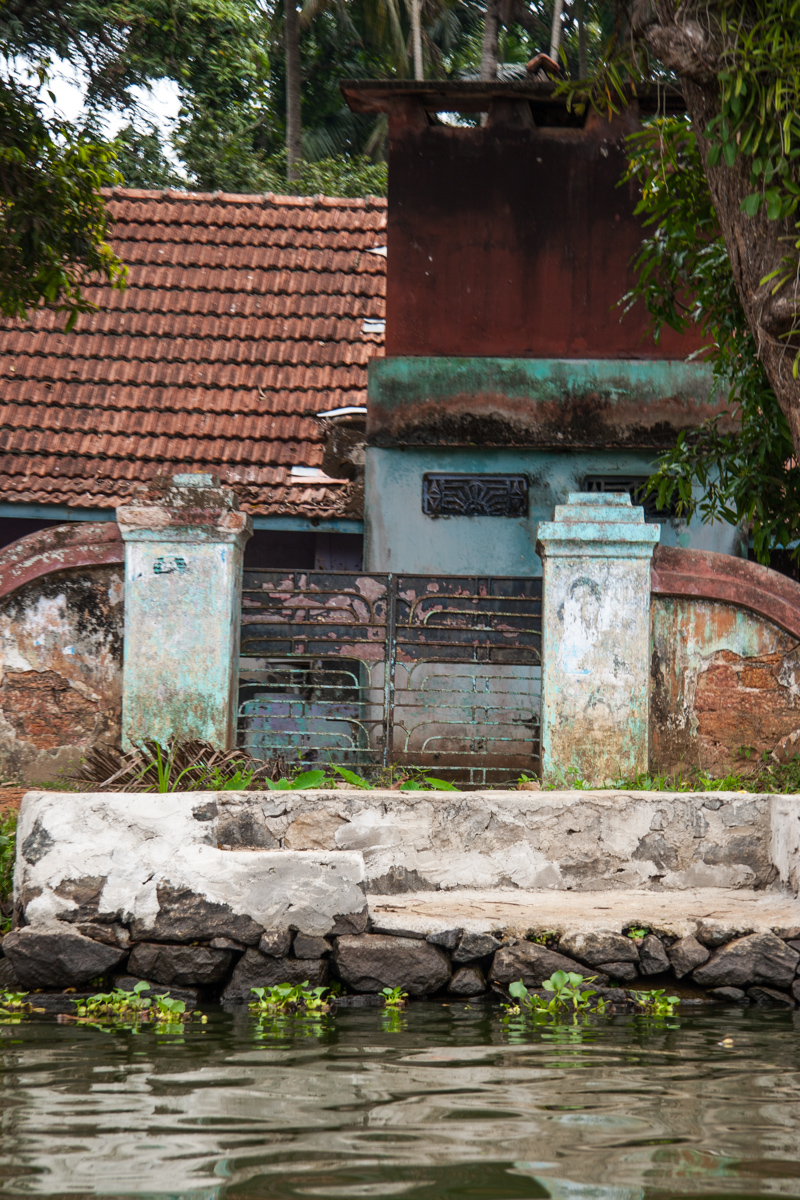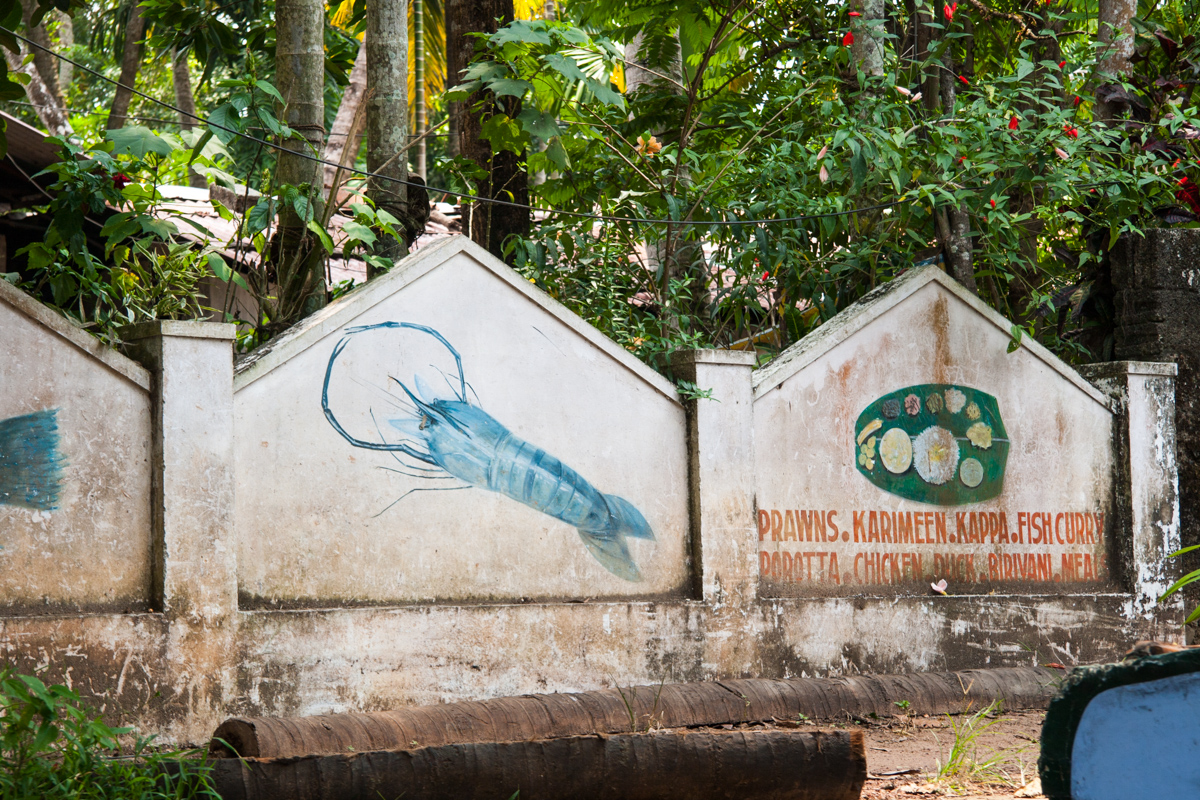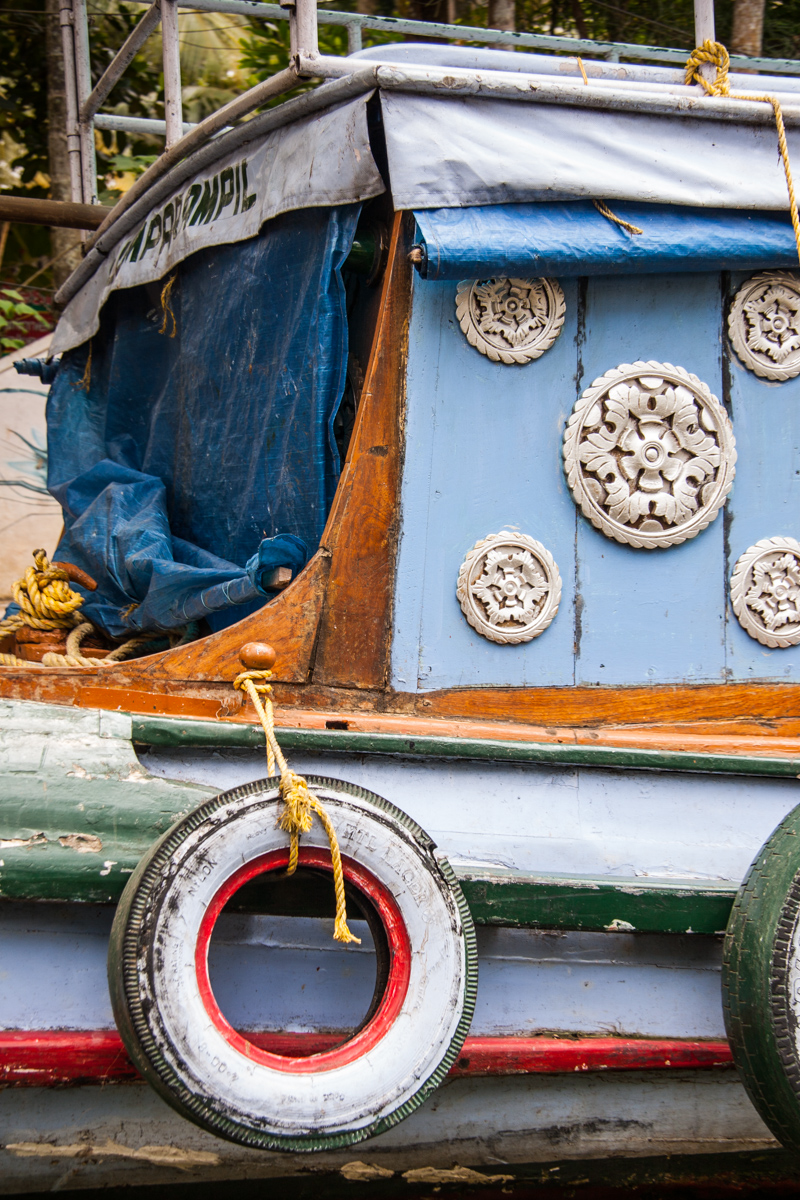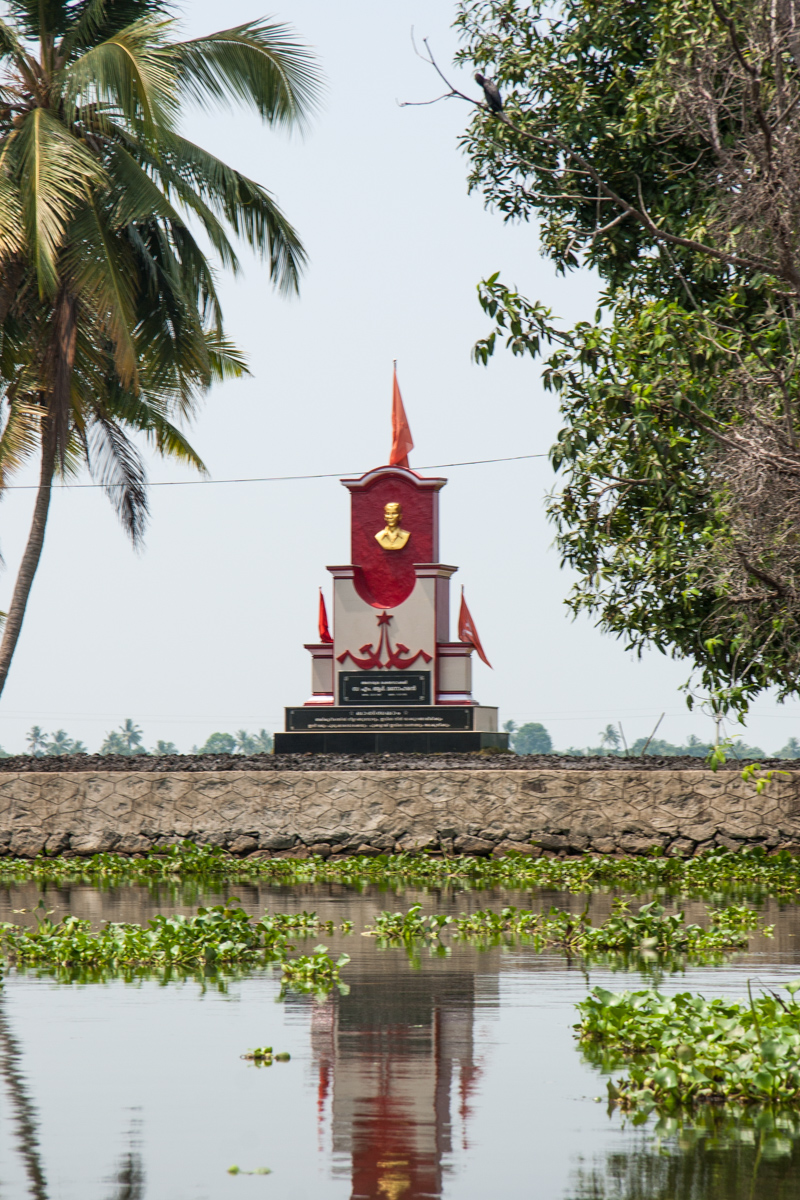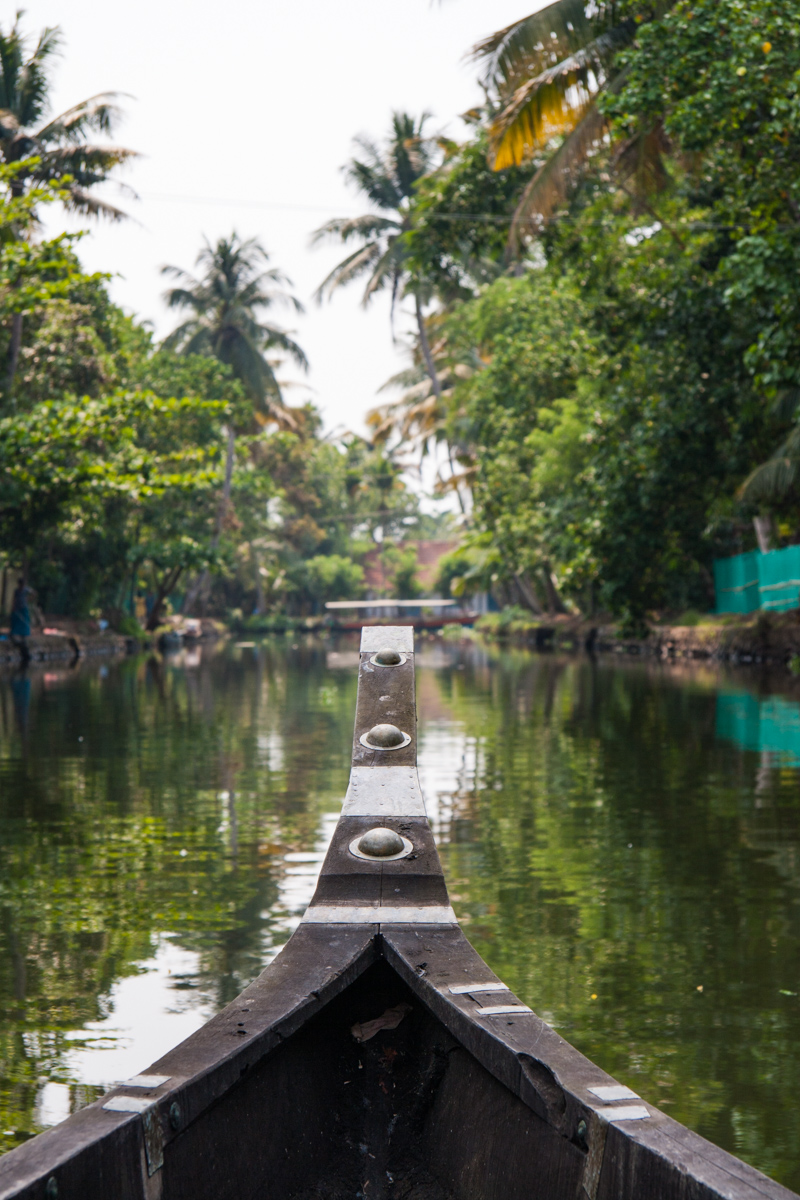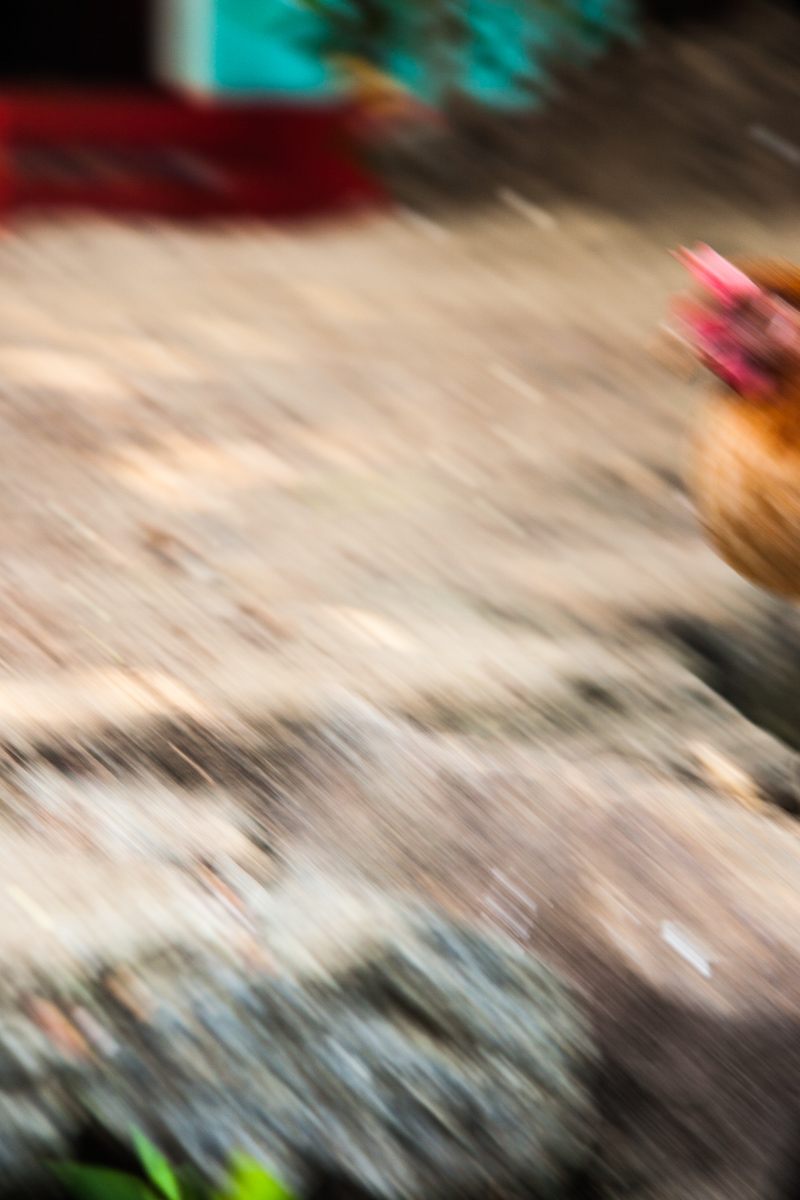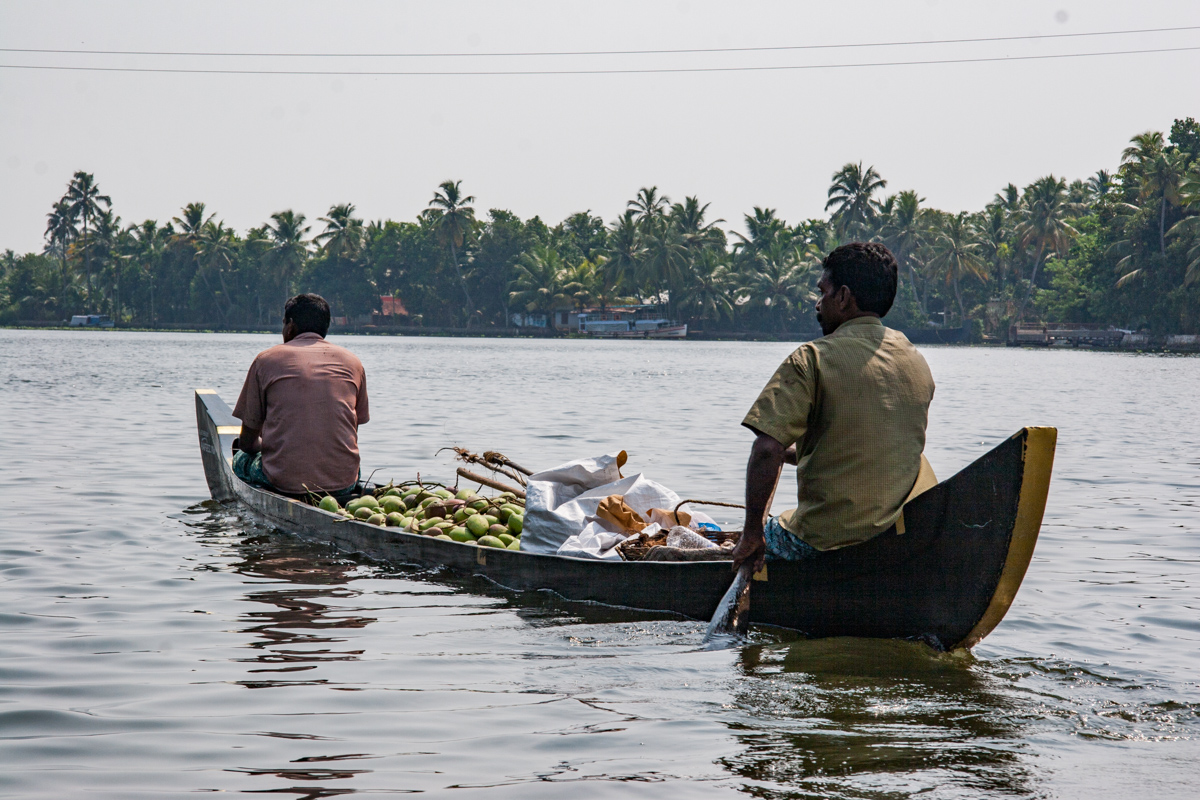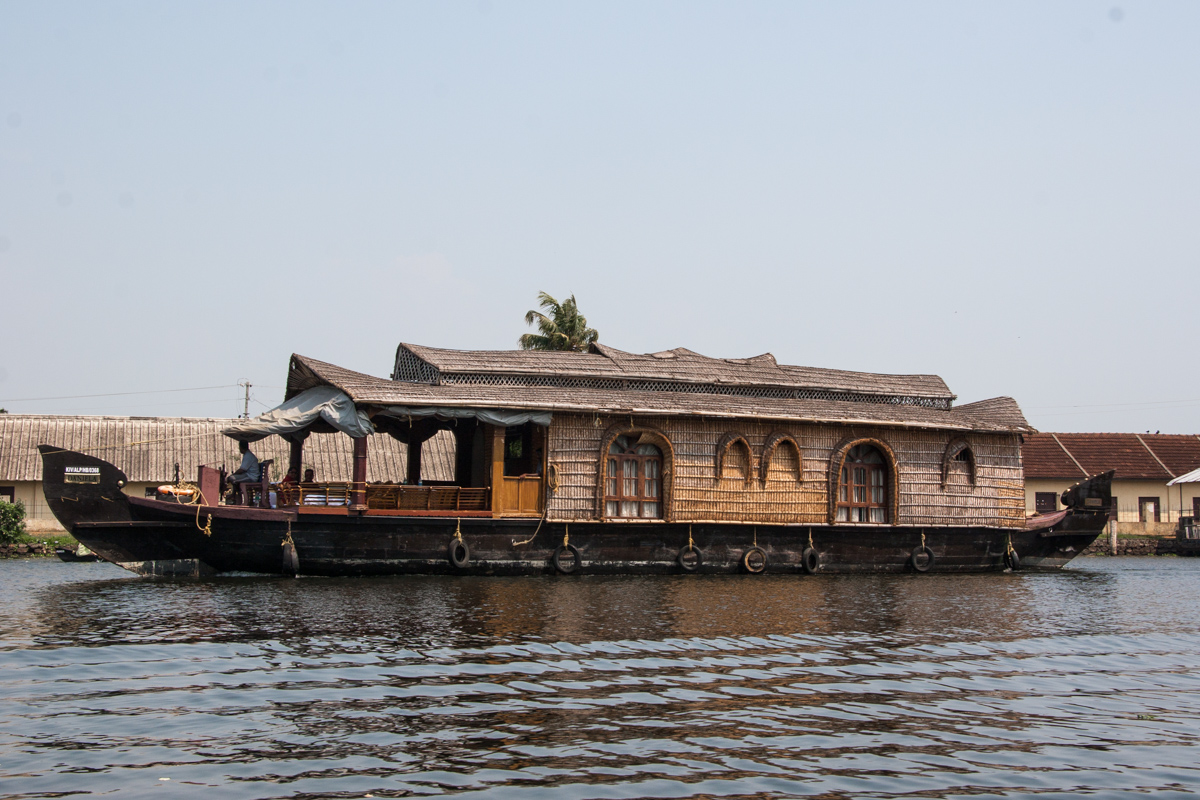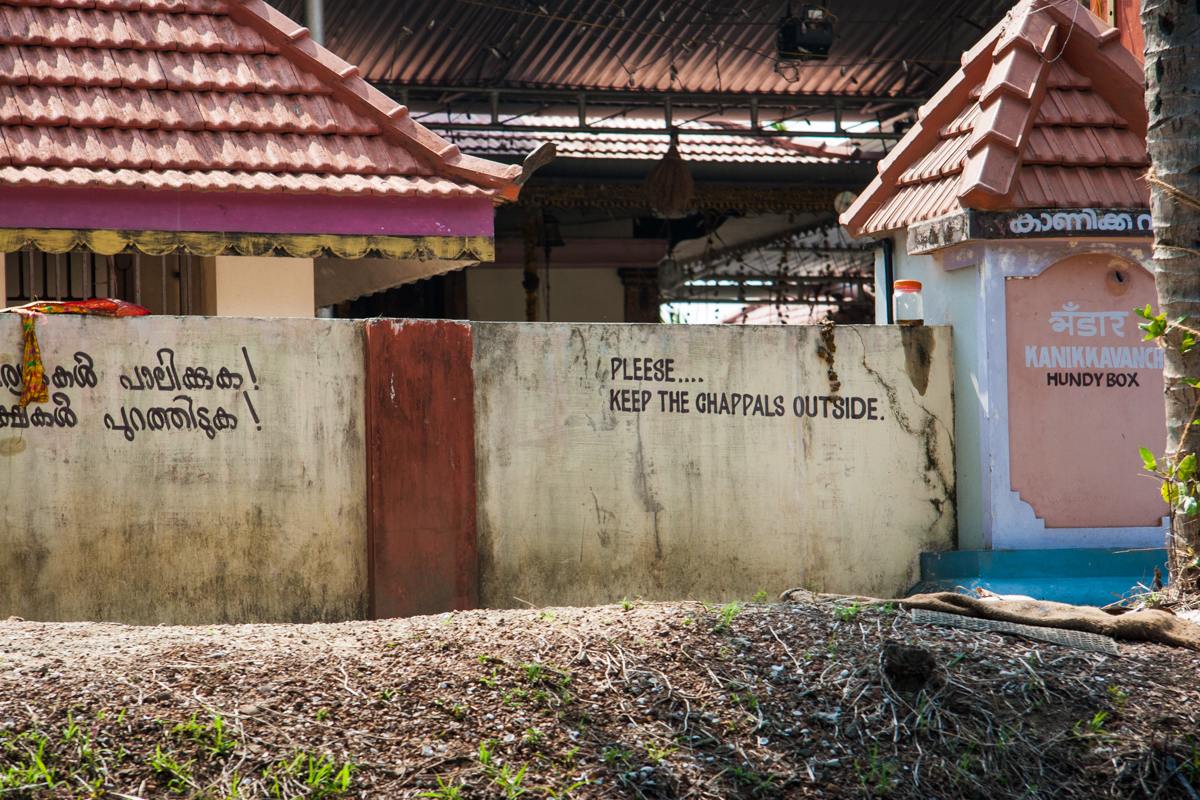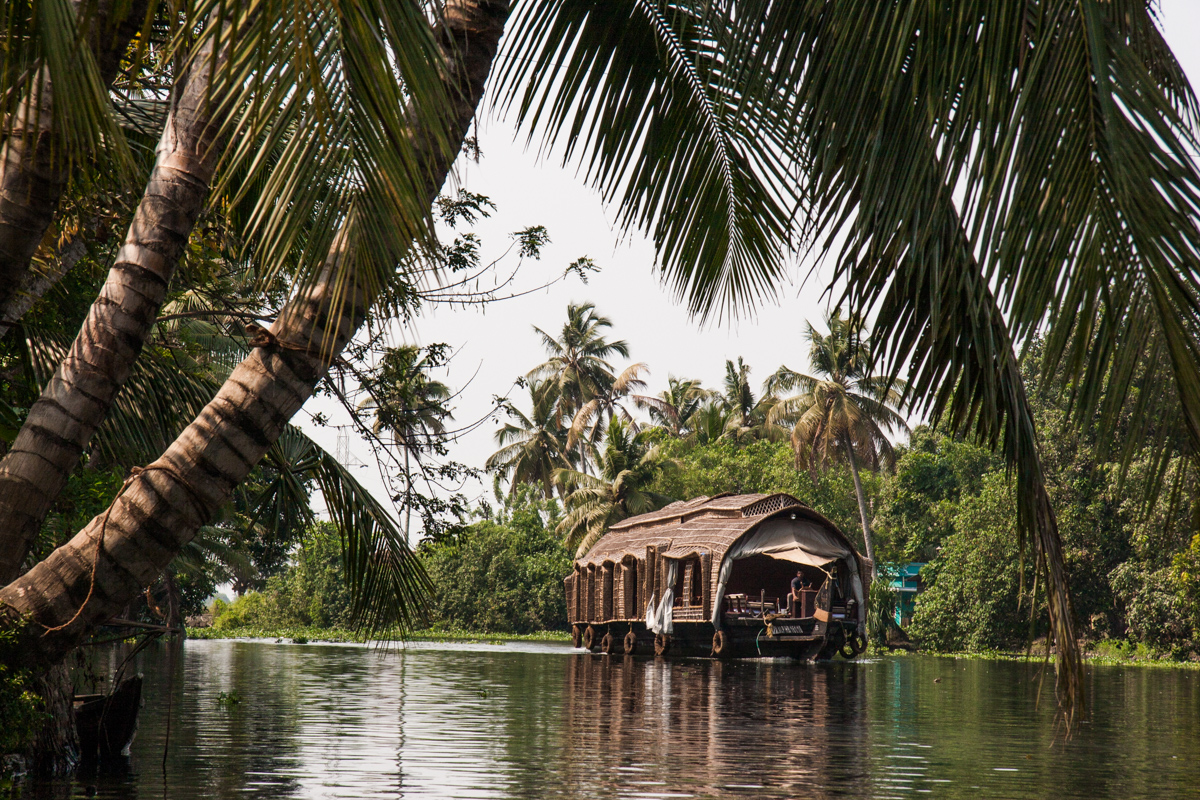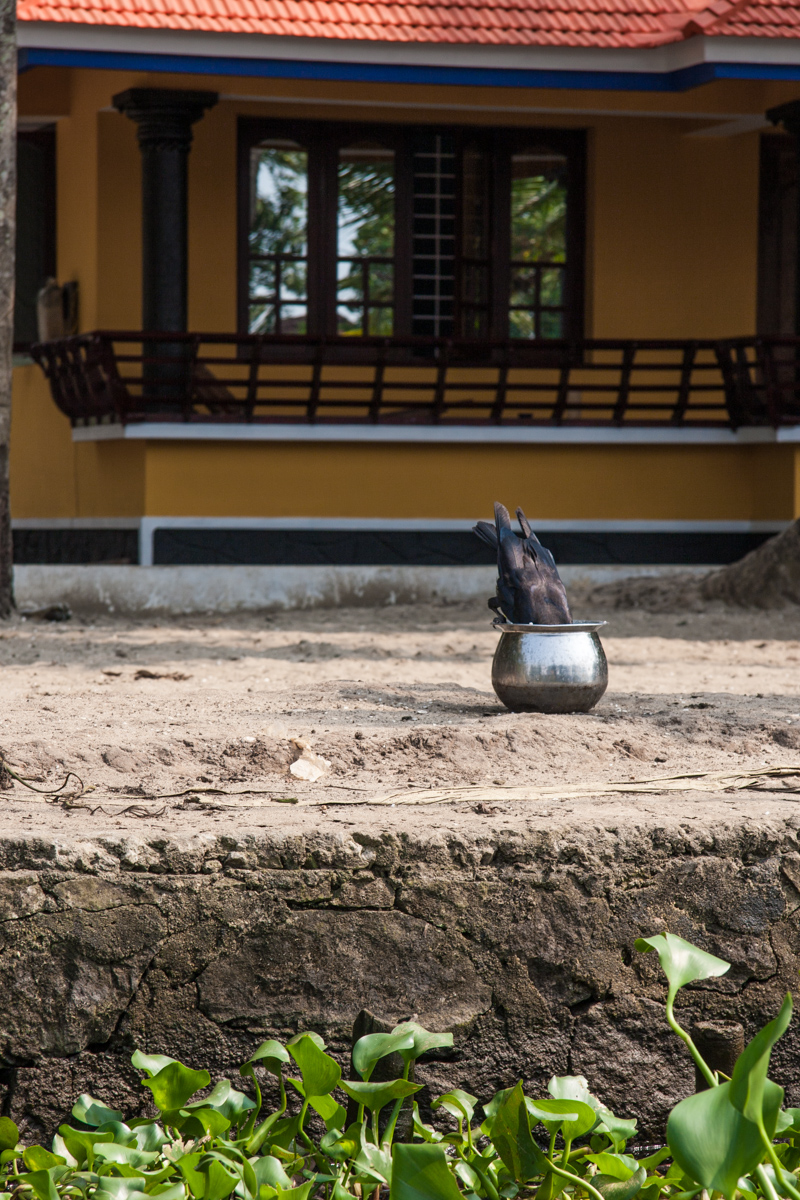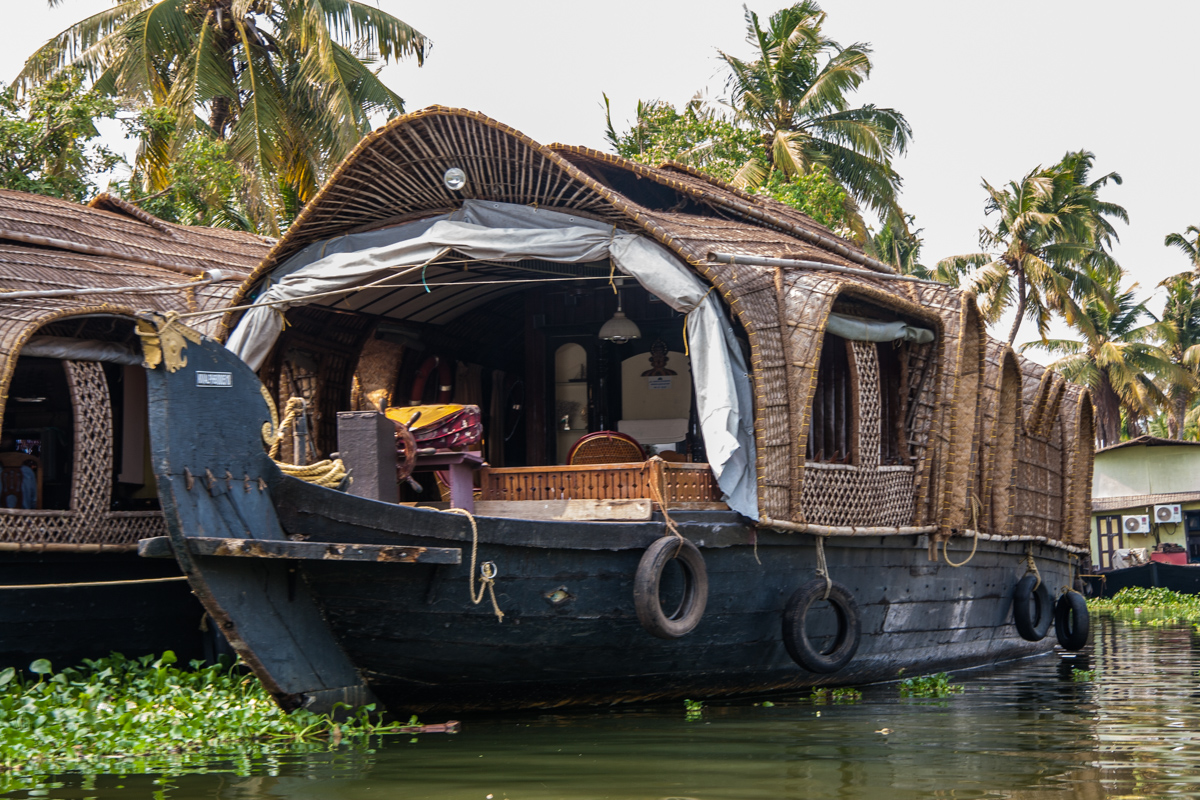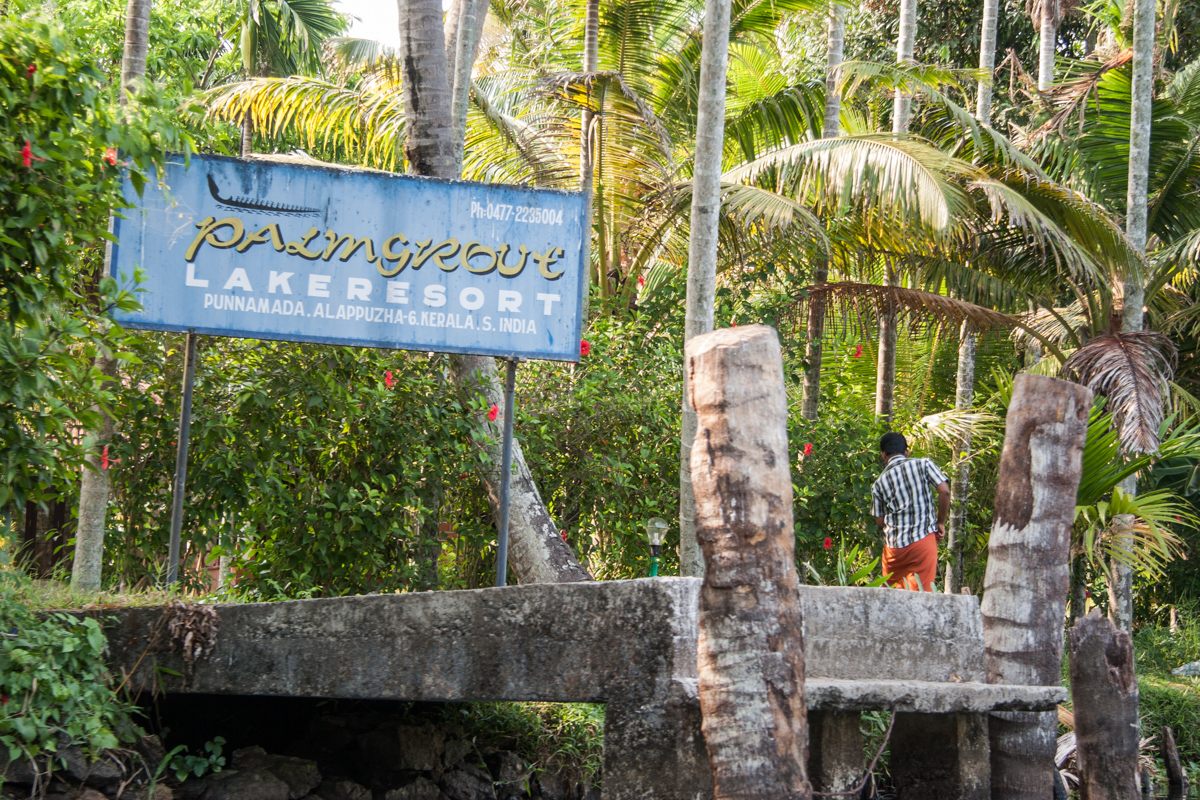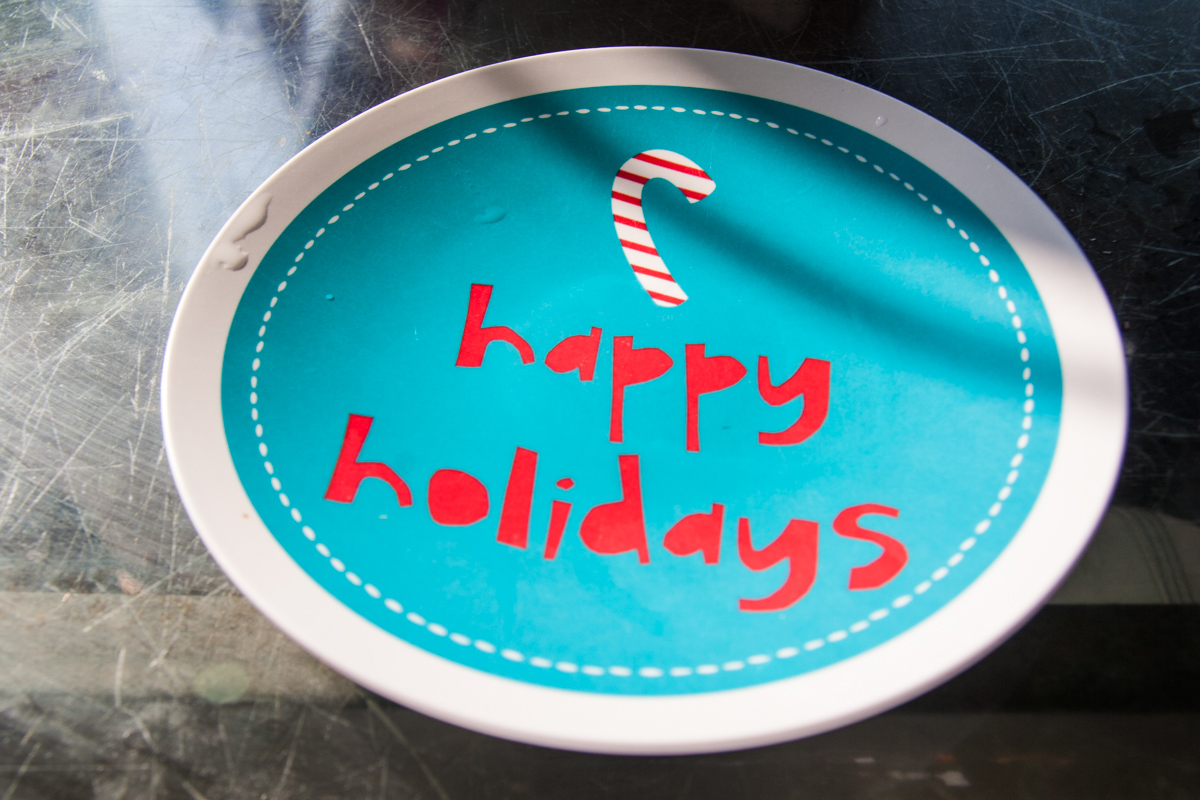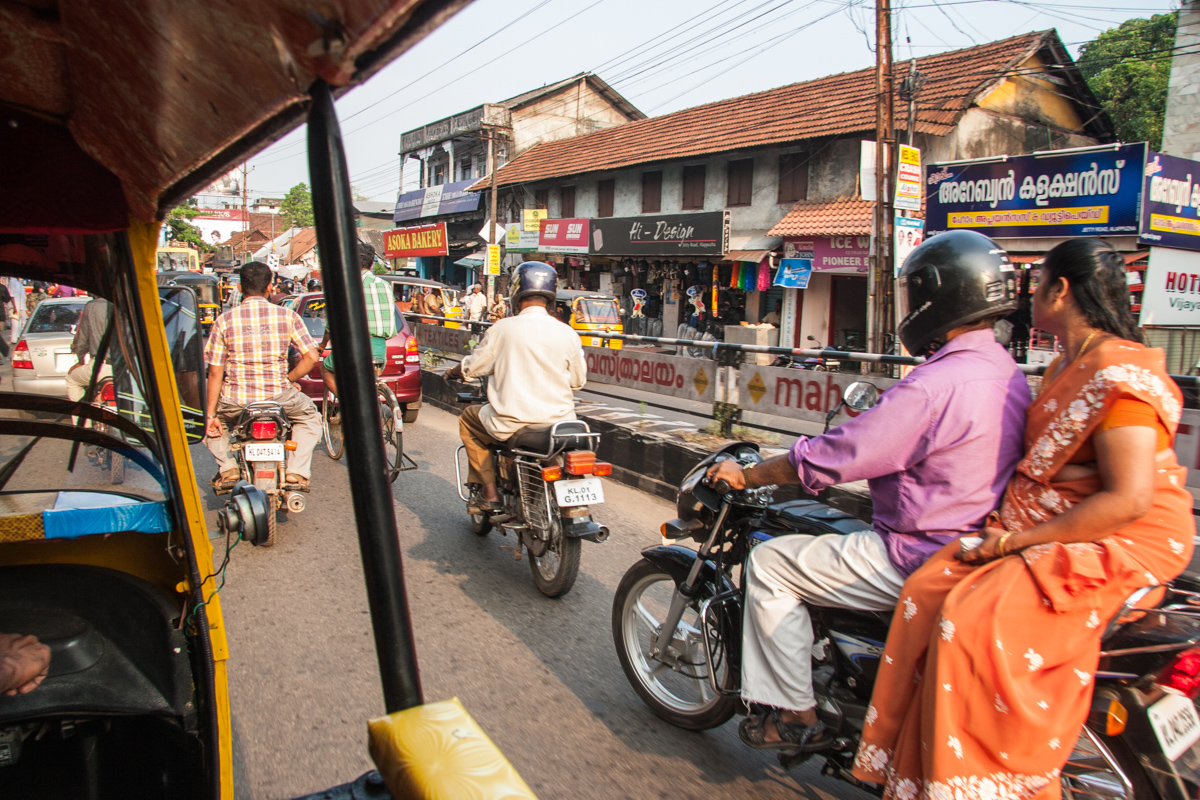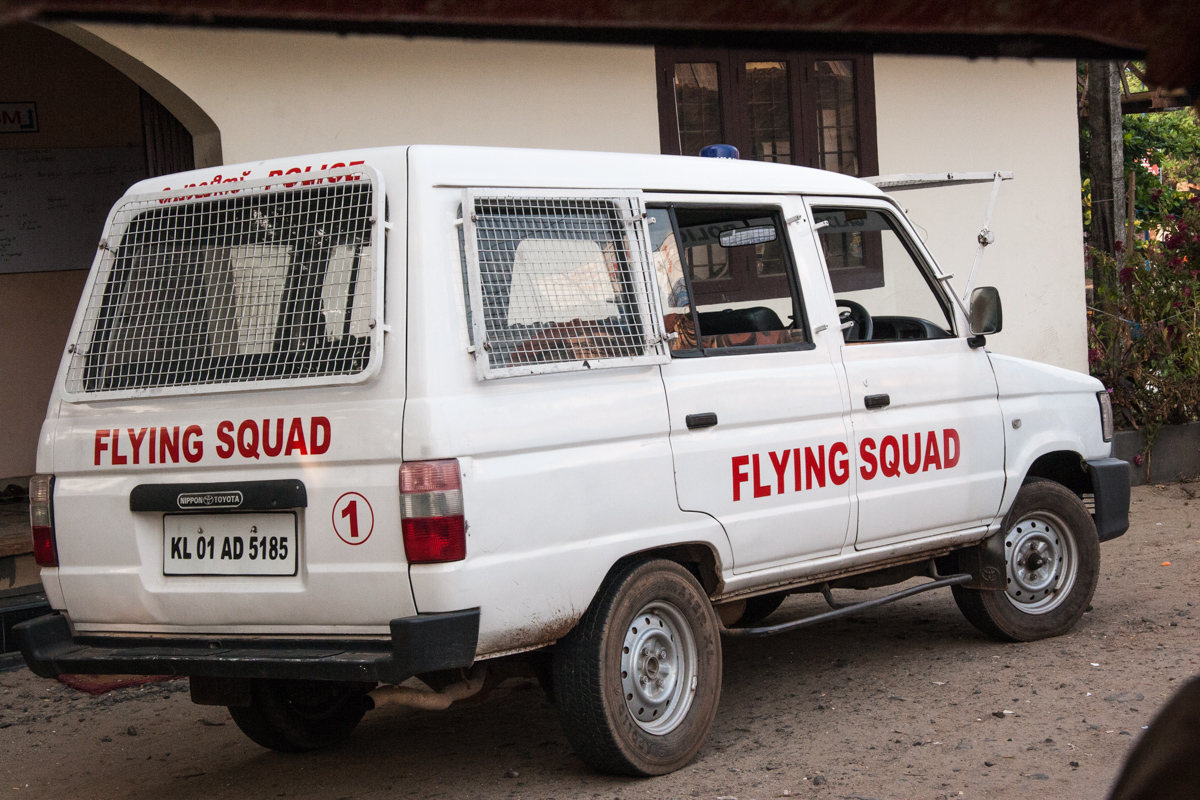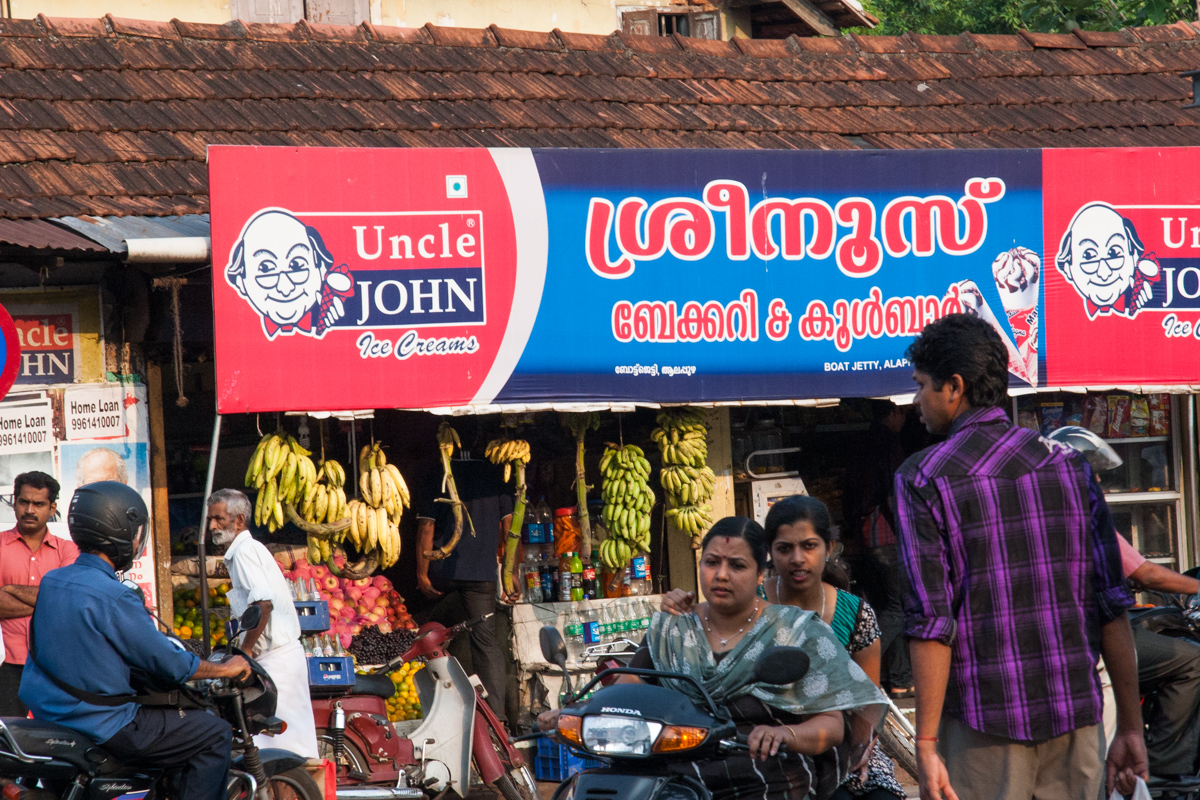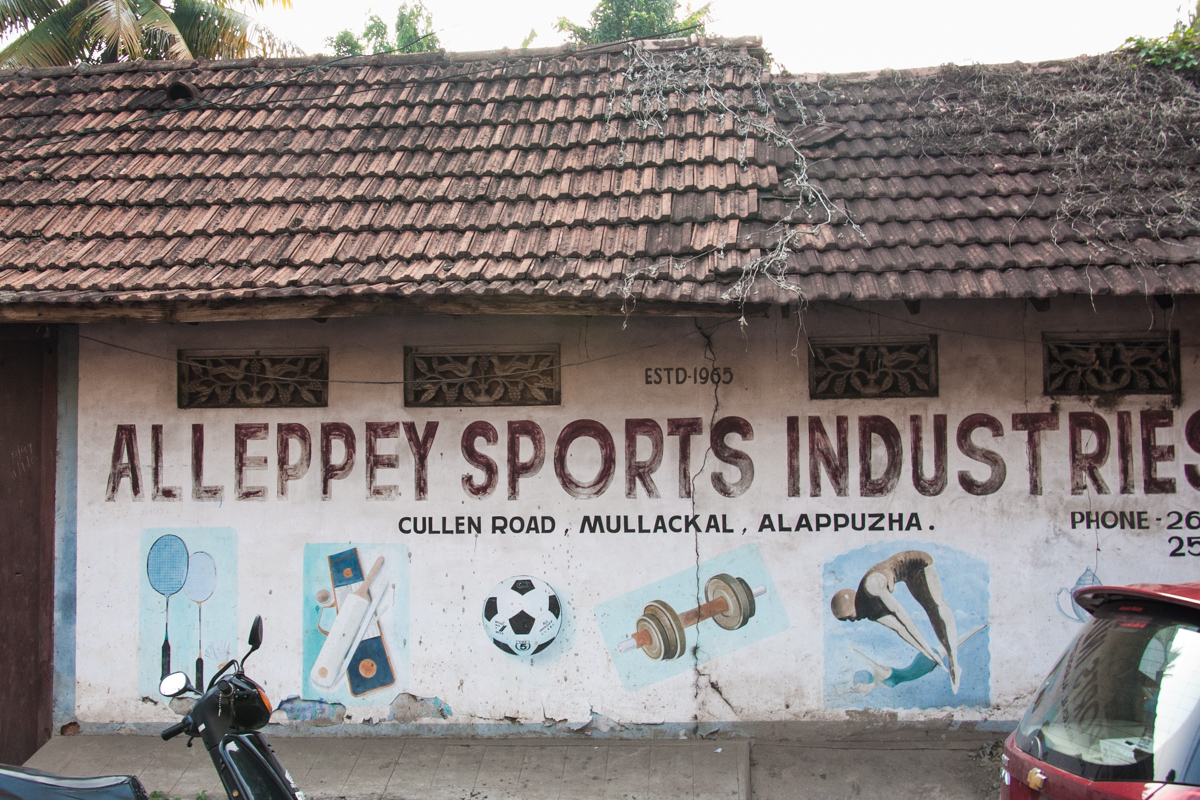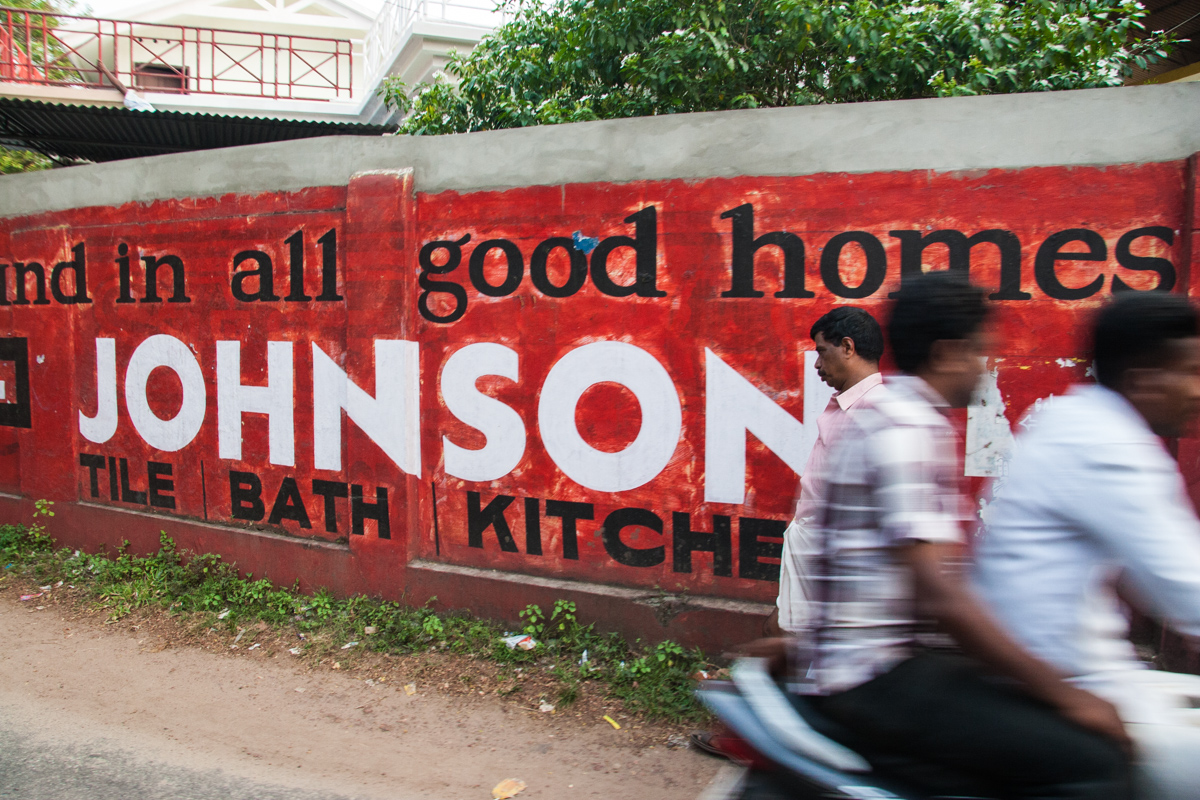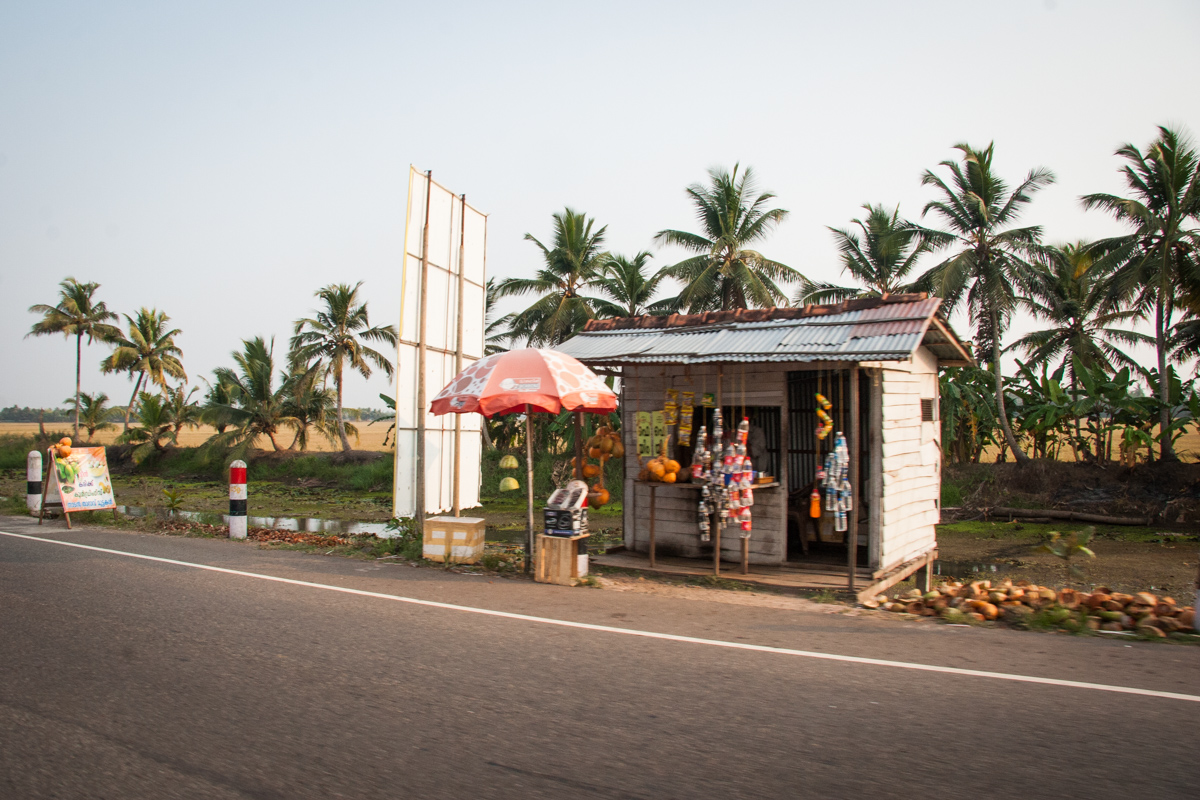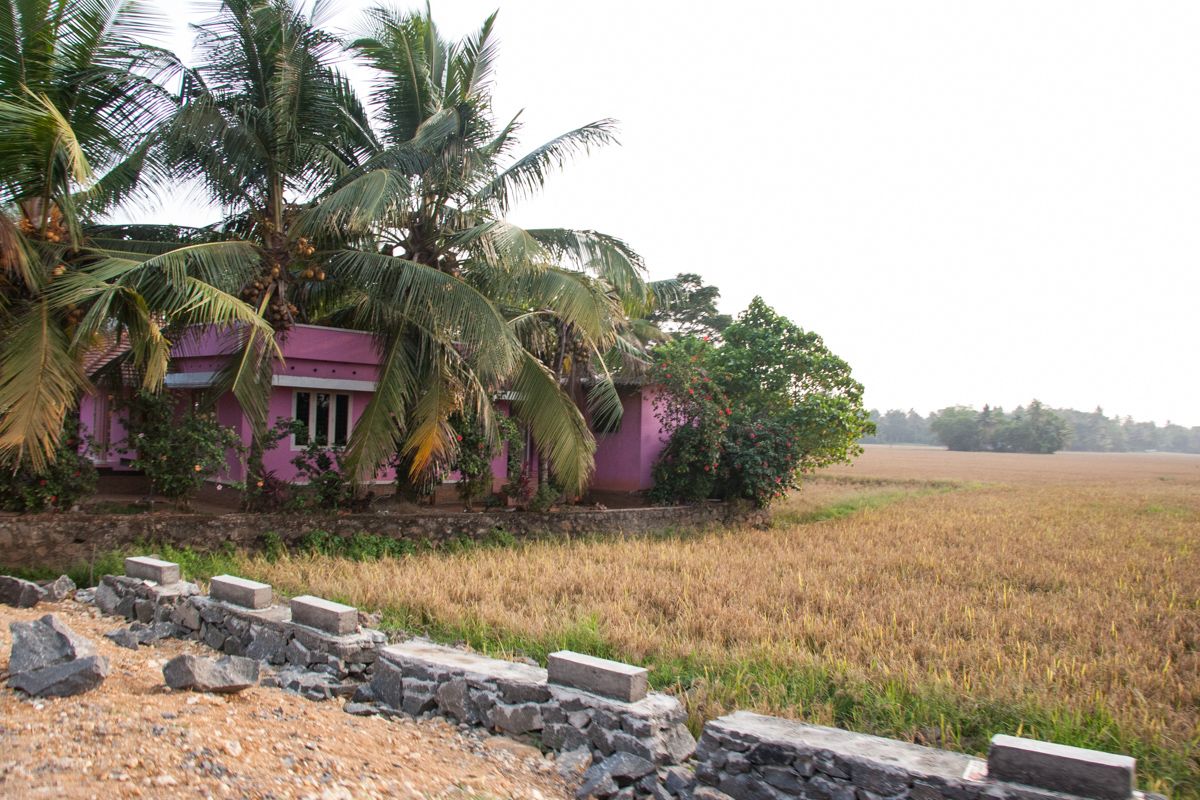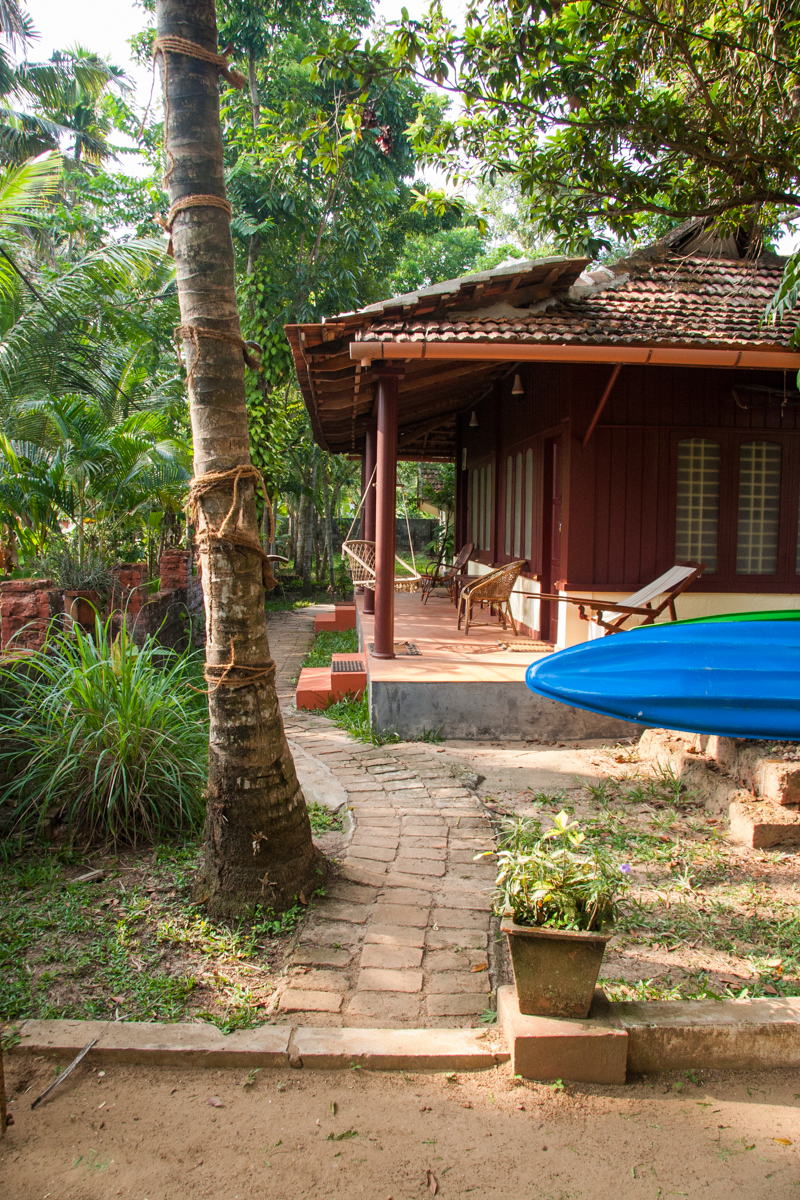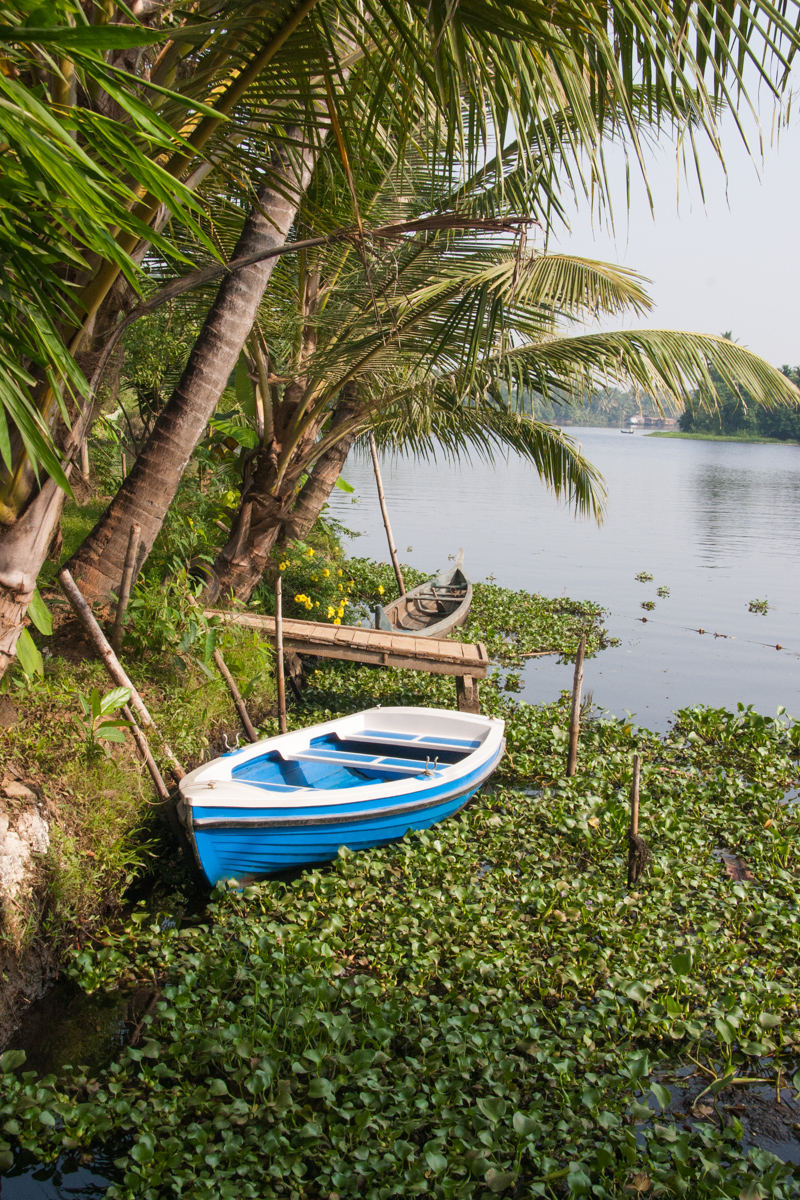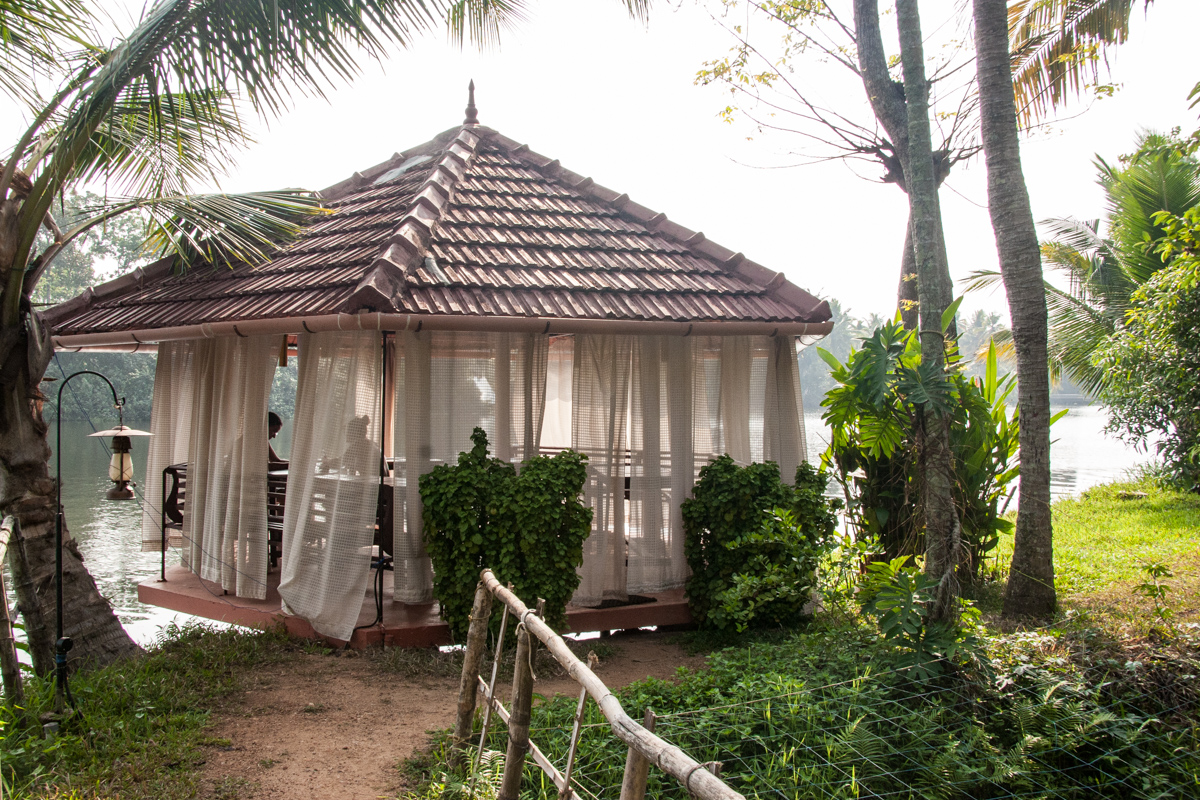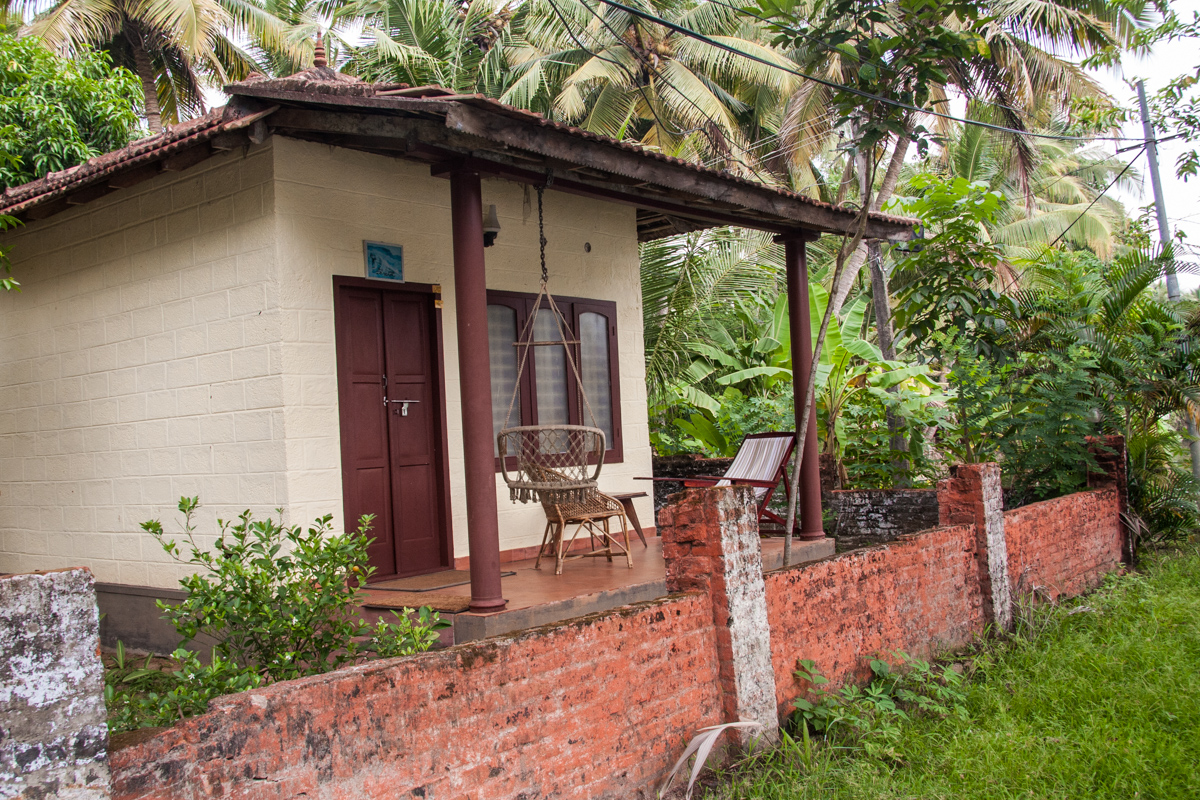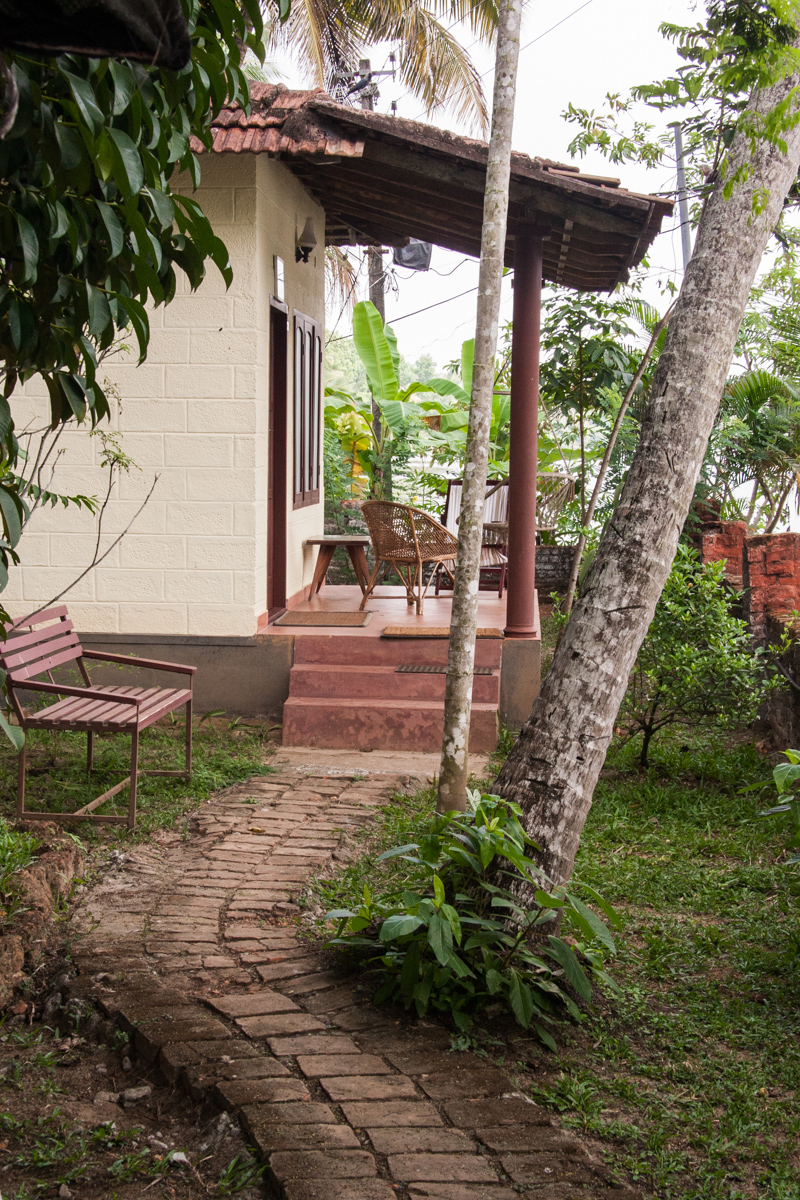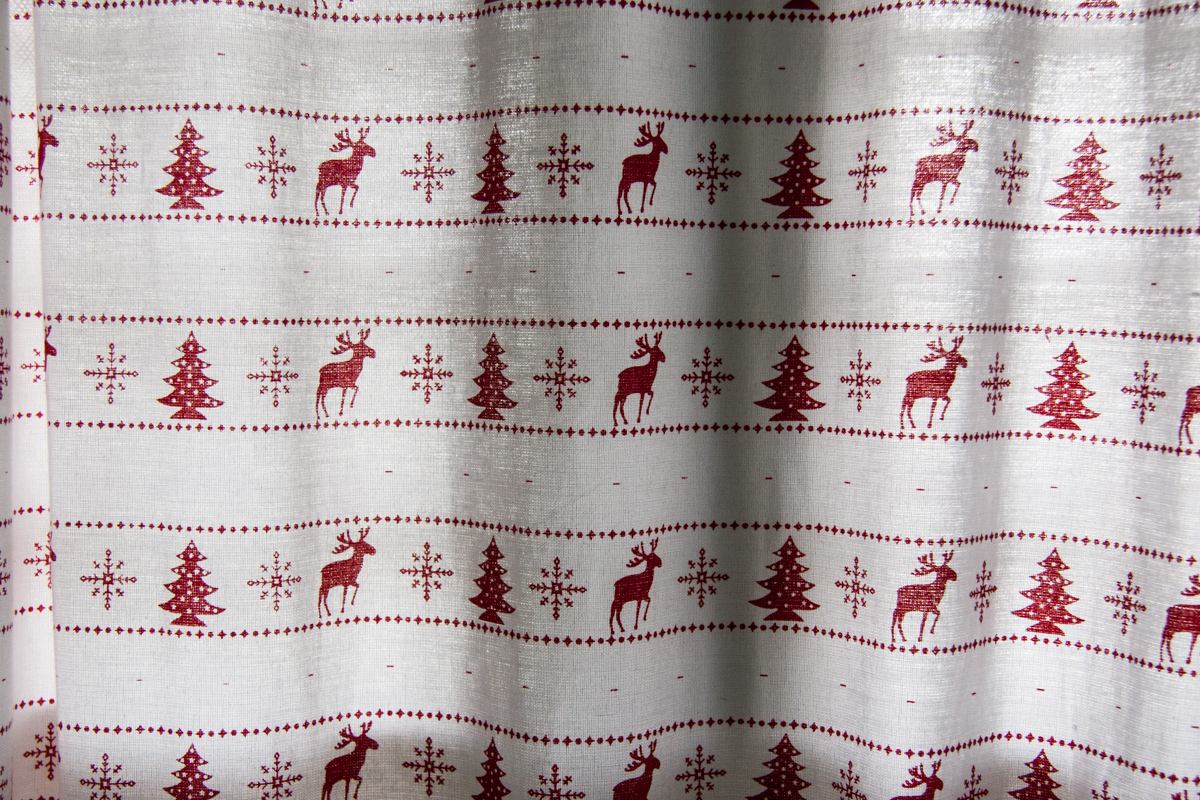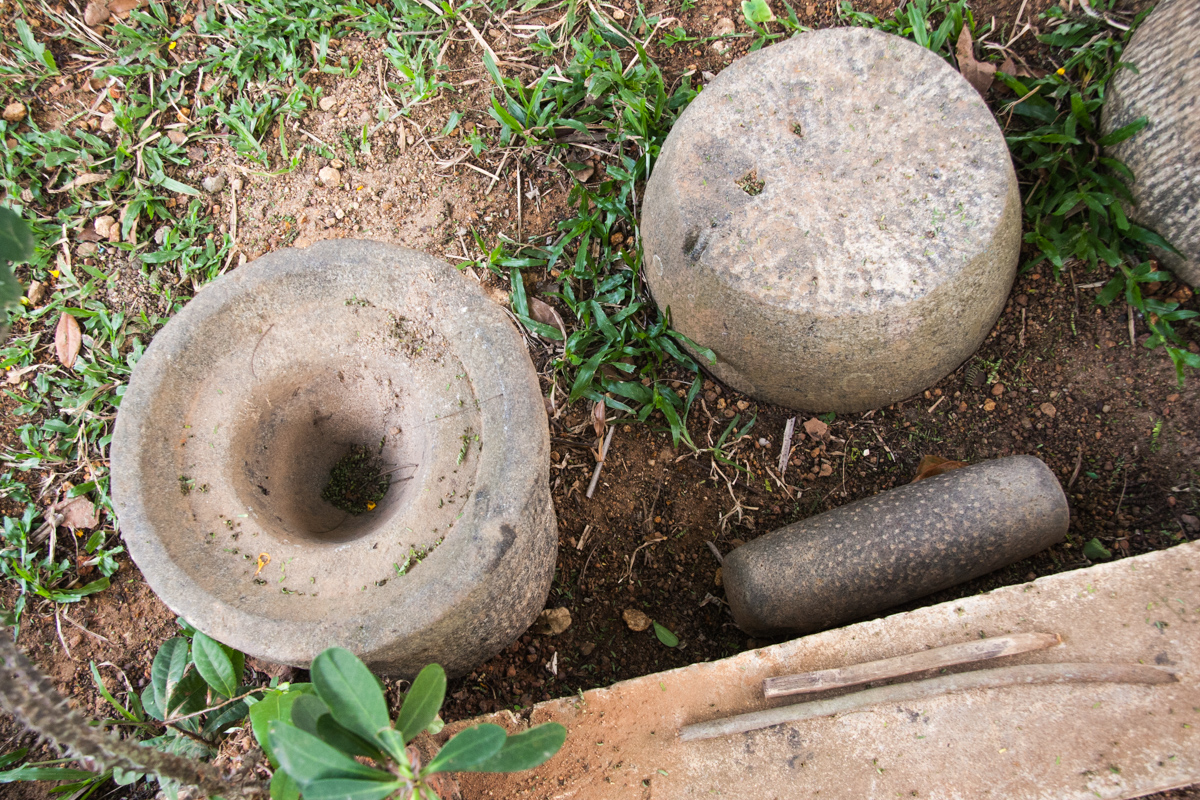Our second stop in Kerala was the Backwaters region near Aleppey, about 50 km south of Fort Cochin. This is an area of interconnected lakes, lagoons, rivers and canals that is known for its beauty and tranquility, and also for the quantity and diversity of its bird life. It is a heavily agricultural region; in addition to rice paddies, coconut palms and banana trees abound, and cashews and rubber are also important crops.
On our way down to the Backwaters, we stopped at BTH Sarovaram in Cochin for a traditional Keralan lunch. Although it was listed in our guidebook, we were the only Westerners there, which we usually take to be a good sign. We ordered the deluxe lunch special, which consisted of several different curries served on a banana leaf, with a variety of other accompaniments. (I found this wonderfully detailed description of the dishes in a TripAdvisor review.) When we sat down, we each had a folded banana leaf at our place setting. Dan didn’t realize he was supposed to unfold his leaf before eating, and started dishing out portions onto his half-leaf. This caused considerable good-natured hilarity among our servers, who promptly stepped in, whisked the leaf away, and brought him a new one (which we were charged for). Everything went smoothly after that, and we learned that you fold your leaf in half at the end of the meal to signify that you are finished eating.
We had booked ahead for two nights at Kait’s Home, another homestay recommended by a fellow guest at Beena’s. This property is located on the banks of the Pampa River in the village of Champakulam, 15 km south of Aleppey. Josey Thomas, who runs the homestay with his wife, is a member of the Christian Mappilacharry family that has been farming their lands in this area for more than 550 years and 14 generations. The land surrounding the house and guest cottages held banana and cashew trees, toddy palms, a pond full of fish being farmed for sale, and there was a large paddy field just over the road. Our accommodations here were in a detached cottage, with a private bath and a small front porch, just a few steps away from the riverbank.
It was late afternoon when we arrived, and Josey recommended that we follow the path along the river to the village center. This was a lovely walk, enhanced by the rosy light of the sun as it went down. We passed a few kids swimming, and some women washing clothes in traditional way by beating them on a flat rock step built into the wall along the side of the river. This was pretty impressive to watch; they use a rapid flicking of the wrist to turn and smack the garment against the rock dozens of times in a minute. This method supposedly gets clothing very clean, but I’ll bet it shortens the lifespan of the fabric considerably.
After a little while, we came to the outskirts of the village, and stopped to visit St. Mary’s Forane Church. It was founded in the 5th century A.D., making it one of the oldest Christian churches in India. The current building is said to date from about 1150 A.D., and it has been renovated several times since then. The interior decorations strongly reminded me of the mission churches we see in California, which is no doubt due to the Portuguese influence in the 17th and 18th centuries. St. Mary’s is a Syro-Malabar Catholic Church. This is the largest denomination of St. Thomas Christians, a term that refers to several groups in India who trace their origins to the Saint’s evangelical activities.
After we were finished seeing the church, we continued on to the village center, which was not at all large. It was late in the day, and since we were definitely not there in high tourist season, there wasn’t too much activity. We stopped at a small shop for some barely-frozen ice cream bars, and then headed back to our homestay in time for dinner.
Our meals at Kait’s Home, once again home-cooked and delicious, were served in a breezy, screened-in pavilion set out over the water. All of the food was lovely, but the dish that really stood out to both Dan and me was the coconut-filled pancakes we were served for breakfast on our first morning. These were similar to blintzes, with the rice-flour pancakes and a filling consisting of slightly sweetened grated coconut with cardamom. They were unbelievably delicious.
As an aside, we were blown away by Keralan food across the board. This cuisine is quite different from the range of dishes you typically see in Indian restaurants in the U.S., which are mainly Moghul-inspired dishes from the North. In the south, the sauces are generally lighter, and there is not as much reliance on cream and other dairy products. Instead, coconut is what adds richness to the dishes. Many of the vegetable curries are fairly dry, and feature finely grated coconut along with onions, mustard seeds, and curry leaves. The ‘wet’ curries often incorporate larger slices of coconut, or coconut milk. Fish and other seafood also feature much more prominently than in the northern regions. Rice, rather than wheat, is the staple grain, and it appears in many incarnations. When served as a side dish, it is typically boiled in a lot of water, like pasta, which gives it a pretty different texture than steamed rice. Rice is also ground and combined with lentil flour to make a wide range of delicious things: small steamed dumplings called idli; thin, crispy dosai that are filled with spiced potatoes and peas; and thicker pancakes called uttapam that are served topped with chopped herbs and tomatoes. We enjoyed this food so much that we have made a fairly serious effort to learn how to cook a number of these dishes, and they’ve become a regular part of our meal rotation. (For the record, I dearly love Northern Indian cuisine as well, and have been working on mastering some of its classic dishes, too.)
We knew we wanted to take a boat tour while we were in the Backwaters, and had to decide between renting a houseboat and going with a smaller, hand-paddled boat. The houseboats usually have a thatched structure above the deck, and are adapted from the traditional style of river barge that is used to move cargo along the canals. Most typical houseboat tours include at least one overnight stay on the boat. Many of the houseboats are quite plush, and we were tempted by this option. But, we read that due to their size, the houseboats often can’t get into the smaller canals. Also, they stop for the night when it gets dark, which was at about 6 p.m. when we were there. If we had been traveling with another couple, we probably would have taken this option, but we decided that we wanted to be able to get into some of the quieter places, and also to have more flexibility with our evening plans.
Dan found a tour operator that was highly recommended in our books and online, and we arranged for a 6-hour tour in a hand-paddled canoe that was about 12 feet long. The boat left from a resort in Alleppey, so we headed up there by tuk tuk first thing in the morning. The boat would have accommodated at least a couple more people, but we had it to ourselves. I was very happy to see that a small roof provided some shade for the seating area.
The first part of our tour was not entirely ideal. It started with what seemed like an interminable lake crossing. It was already very hot by 9 a.m., and the glare off of the water was so dazzling I had to keep my eyes mostly closed. Since the boat was hand-paddled, we did not move very quickly, and it seemed to take a very long time to cross a pretty broad expanse of lake. There wasn’t a whole lot to see at this point, and the heat and gentle swaying of the boat had a very strong soporific effect on me. At one point, Dan asked the boatman to make sure we would be seeing some of the smaller canals, after which the boatman kept repeating “Twenty minutes. Twenty minutes to small canal.” over and over. (It was a lot more than 20 minutes before we got across that lake.)
Once we got into the smaller-and shadier-waterways, things improved considerably. Water is definitely the main thoroughfare and means of getting around in this area. Padding through the smaller canals was essentially like walking down residential streets. Most homes were very close to the water’s edge, and often had stone steps right outside their front doors that led down into the water, with a ledge next to the steps for doing laundry. We saw chickens wandering around in front yards; crows drinking from water jugs that had been left out for them; kids playing, and people working their paddy fields.
Our boatman continued to be a character throughout the day. His English was limited, so we didn’t have a lot of conversational opportunities. He did react when Dan started singing to himself by singing a song of his own. However, he didn’t react at all when I started shaking my right leg and howling in pain because a very large ant had just climbed up my pant leg and bitten me three times in quick and very painful succession. At one point, we pulled up alongside another boat that was being paddled by his boss, and realized that our boatman was an employee of the tour guide who had gotten such positive reviews. We probably would have gotten a bit more out of the tour with another guide, but all in all this was a worthwhile experience. It was great to be able to soak in the scenery and observe daily life at a leisurely pace.
We finished up our tour in mid-afternoon, and after that stopped in Aleppey for a milkshakes at a stand called the Sweet Spot snack. Once refreshed, we took a little walk around town and then headed back to our homestay for our last, quiet, evening in the Backwaters.
